Nerium oleander (Oleander) is a large evergreen shrub or small tree suitable for warm and temperate climates. It has a good variety of flower colours, and has long shiny dark green leaves. The variegated variety has bi-colour leaves of green and yellow. Oleanders flower for most of the year, and are happiest in a full sun position. They will also tolerate coastal conditions. Once established they are very hardy. Care must be taken when handling all parts of this plant as it is toxic. Oleanders grow well in Sydney, where these photos were taken.
Authors get paid when people like you upvote their post.
If you enjoyed what you read here, create your account today and start earning FREE STEEM!
If you enjoyed what you read here, create your account today and start earning FREE STEEM!
The story of oleander flowers, the symbol of romance and charm, is described in Greek mythology: The young man named Leander swims every night to face the young girl sitting on the opposite bank of the Greek Sea (Marmara) and see him. Again in a stormy september, Leander, who is burning with the love of his lover, leaves herself in horny waters. Leander, unable to withstand the violence of the storm, is about to arrive on the opposite shore and is dead from exhaustion in the dark waters. The horny waves leave the inanimate body of the flock to the white sands, struggling to see once again their love. Seeing this, the young girl puts the oleander flowers he collects for his lover into Leander's lifeless body.
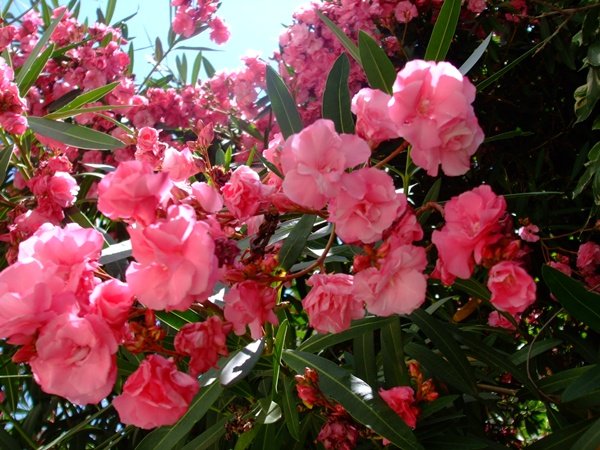
Since that day, oleander flowers have embellished as the symbol of Leander's endless love.
The common name of the oleander, called "oleander" on many foreign languages, comes from Leander, who is strangled to see his love. In our country, it is also known as the tree-tree, the tree-tree and the tree of the struggle. You know the phrase "the roots of my stomach." (For example, the expression "eat the roots of my fortune", which is often used by mourning mothers for meals!) The "wreck" here is actually the zakkumun itself. Oleander, a very poisonous plant, was also used as a potent poison in ancient times. Because of this feature, in some regions it is still known as "killing donkey".
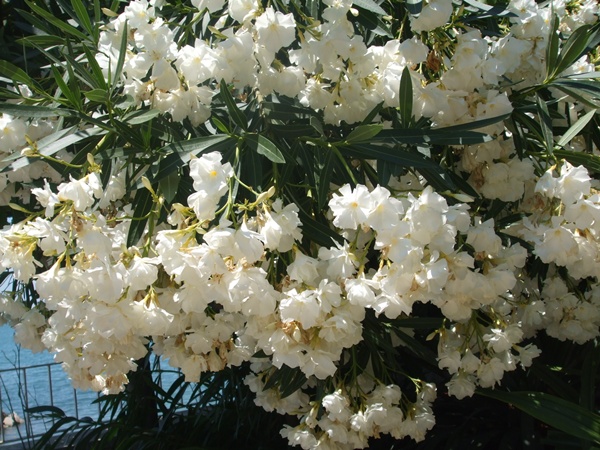
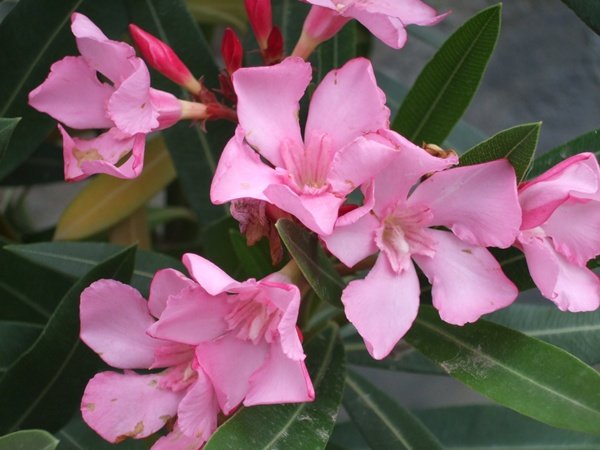
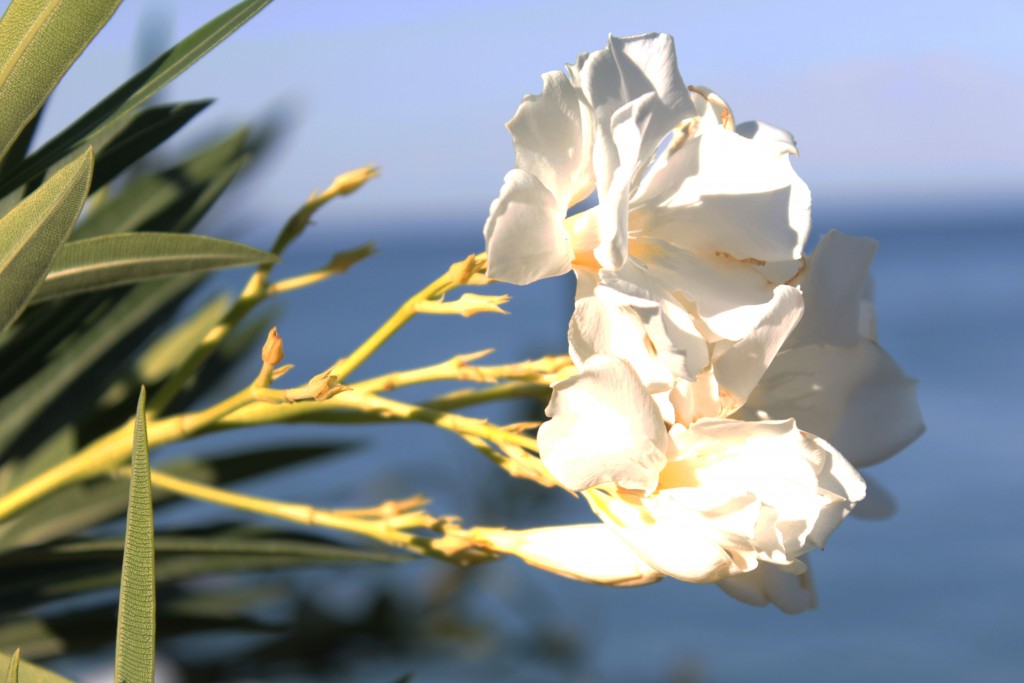
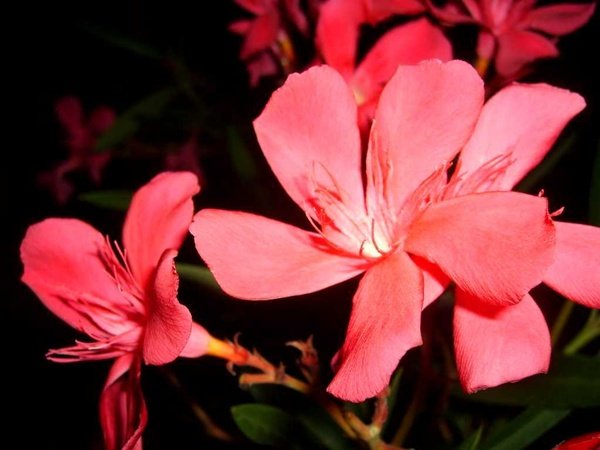
Picture source
Downvoting a post can decrease pending rewards and make it less visible. Common reasons:
Submit
Some very interesting info here, and great pics! You won the Silly Sausage Award, well done !
Downvoting a post can decrease pending rewards and make it less visible. Common reasons:
Submit
thank you.. :)
Downvoting a post can decrease pending rewards and make it less visible. Common reasons:
Submit
Kaner (Nerium oleander/indicum) is an ornamental shrub or small, densely branched tree, 1 to 10 m tall in the Dogbane family Apocynaceae. Leaves are in pairs of three or whorled, very green, leathery, narrowly elliptic to linear entire. Flowers grow in clusters in terminal branches, each 2.5 to 5 cm, funnel-shaped with five lobes, fragrant, various colors from pink to red, white, peach, and yellow.
The common oleander is one of most poisonous plants that have been shown to contain nondigitalis cardiac glycosides. Oleander is an idiom for plants of the N. oleander L, N. indicum, and, Nerium odorum, species. Common names include soland, lorier bol, rosebay, and rose laurel and kaner.
The oleander is most prevalent, and alluring flowers make it a particular hazard for accidental ingestion. The plant also has shown toxicologic importance for accidents when used in folk medicines, when adults unknowingly eat parts of the plant, or food that has come into contact with the plant, such as hot-dog sticks, and in homicides or suicides. Also, as our case illustrates, toxicities are not limited to temperate climates.
All parts of the oleander plant contain cardiac glycosides, including the roots and the smoke produced from burning, as heat does not inactivate the glycosides. The toxic component are the two potent cardiac glycosides, oleanderin and neriine, which can be isolated from all parts of the plant, Both are very similar to the toxin of Foxglove.[4] Both have positive inotropic, negative chronotropic, and cross reactivity. This includes direct glycoside poisoning of the sodium-potassium pump of the heart and increased vagotonia. Most symptoms from oleander poisoning are cardiac and gastrointestinal in nature and appear four hours after the ingestion.
Source
Downvoting a post can decrease pending rewards and make it less visible. Common reasons:
Submit
OLEANDER IN THE QUR'AN..
Oleander, meaning turkish bitterness and poison, is a deadly tree believed to be in Hell according to Islamic religion. Such narrations about the oleander tree are actually more than information, rather than discourse. Because in the Qur'an there is a clear surplus of oleander words for a few periods and months. I should not pass on these verses before sharing with you;
"Of course, the oleander tree is the food of sinners in Hell. The oleander tree is like a molten metal. It boils like a boil of hot water in people's wombs "(Ed-Duhan, 44 / 43-46)
"Is this meal better for a meal? Or is it an oleander tree? Surely We made him a trouble for the wrong-doers. It is a tree from the bottom of hell. His buds are like heads of demons. Hellstools then eat their places and their bellies with them. Then they shall be given drink upon their oleander tree, with drink mixed with boiling water "(es-Saffat, 37, 62-67)
"Then you, O those who stray from the right path and deny the truth! You will surely eat the oleander tree in hell. You will fill your bellies with it. You will drink boiling water on the threshing floor, "(al-Vakia, 56 / 51-55).
Apart from these; "If a drop of Hell's Zakkum was dropped on the earth, it would poison people's lives" (al-Musnad, Cairo 1313, I, 301).
Source:
Source:
Source:
Source:
Downvoting a post can decrease pending rewards and make it less visible. Common reasons:
Submit
source:
Source:
Oleander is a medically used plant. Experiments are done in cancer drugs. Oleandrin which is in the chemical content of oleander is used medically. Included are diuretic and heart strengthening effects. If the prescribed amount of treatment is exceeded, it causes severe poisoning which is manifested by heart failure, vomiting and diarrhea.
These medications are given only by the doctor's supervision. The maceration with olive oil is externally applied to the skin. It is used against parasites such as biting in the body.
Source:
Source:
Downvoting a post can decrease pending rewards and make it less visible. Common reasons:
Submit
Nerium oleander, commonly known as oleander, is a highly toxic plant that has been cultivated since ancient times. Nerium oleander is a highly toxic ornamental shrub widely cultivated in the Mediterranean.thanks to sharing for your good post.. @ctrl-alt-nwo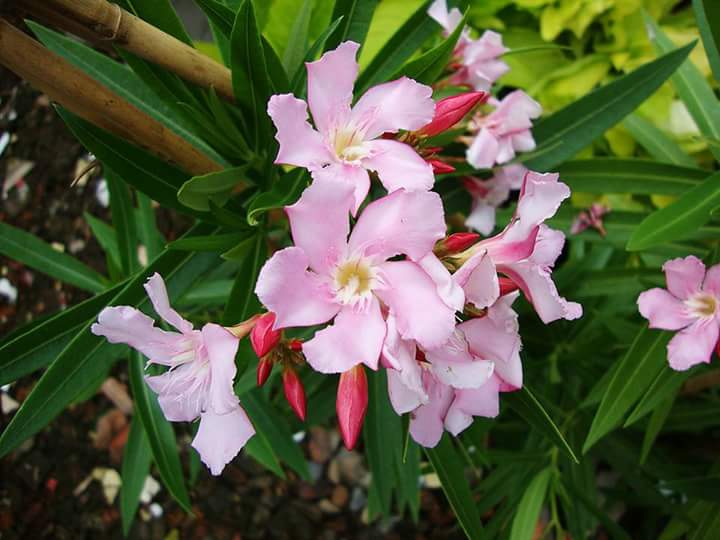
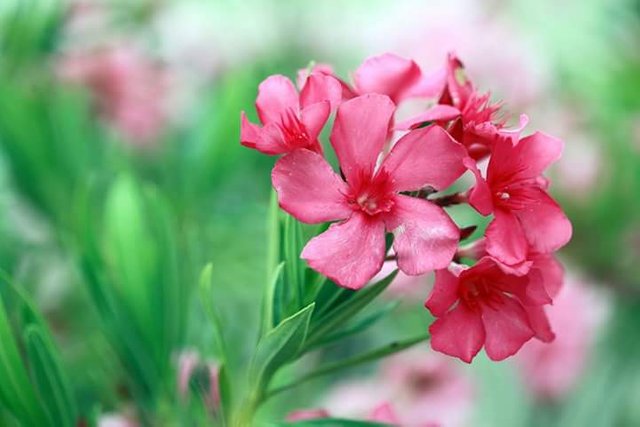
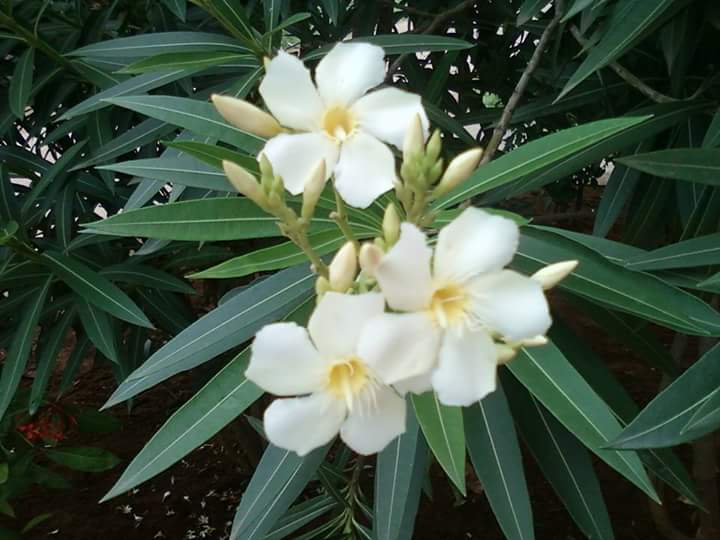
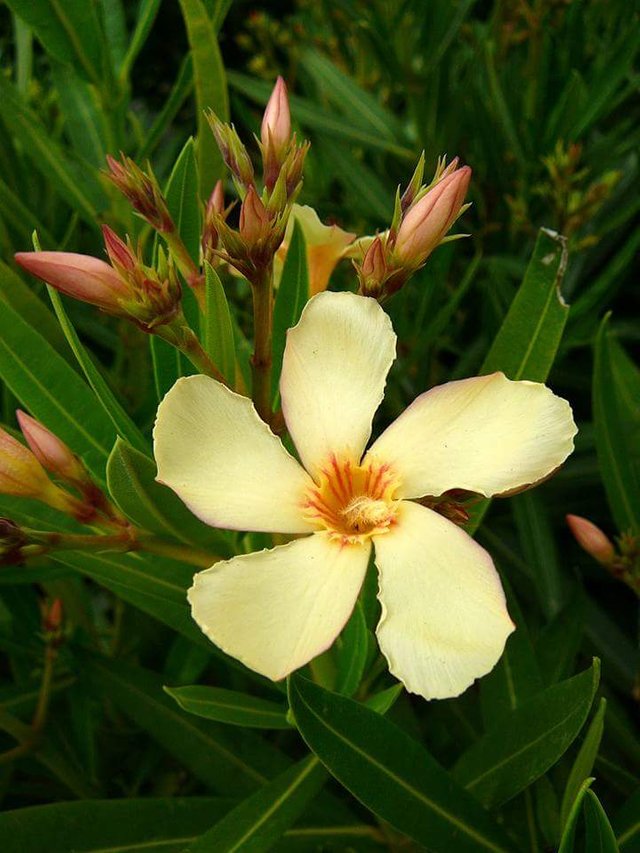
Downvoting a post can decrease pending rewards and make it less visible. Common reasons:
Submit
Nerium oleander is a shrub or small tree in the dogbane family Apocynaceae, toxic in all its parts. It is the only species currently classified in the genus Nerium. It is most commonly known as nerium or oleander, from its superficial resemblance to the unrelated olive Olea. It is so widely cultivated that no precise region of origin has been identified, though southwest Asia has been suggested. The ancient city of Volubilis in Morocco may have taken its name from the Berber name oualilt for the flower.Oleander is one of the most poisonous commonly grown garden plants.
Range Description:
This species is considered to be native to Spain, the Balearic Islands and Morocco east through Mediterranean coastal countries to the Arabian Peninsula, Ethiopia, Niger, Afghanistan, Iran and Iraq to India and central China. It occurs as a non-native in parts of Africa, the Azores, Japan, Indonesia, Australia, New Zealand, the United States, central and eastern Mexico, Central and South America.
Countries occurrence:
Native:Afghanistan; Albania; Algeria; China; Cyprus; Ethiopia; France (Corsica, France (mainland)); Greece (East Aegean Is., Greece (mainland)); India; Iran, Islamic Republic of; Iraq; Italy (Italy (mainland), Sardegna, Sicilia); Lebanon; Libya; Morocco; Myanmar; Nepal; Oman; Pakistan; Palestinian Territory, Occupied; Portugal (Azores - Introduced, Portugal (mainland)); Saudi Arabia; Slovenia; Spain (Baleares, Spain (mainland)); Tunisia; Turkey (Turkey-in-Asia, Turkey-in-Europe); United Arab Emirates
Introduced:Australia (New South Wales); Brazil; Cameroon; Chile (Juan Fernández Is.); French Polynesia (Society Is.); Honduras; Indonesia (Jawa); Japan; Kenya; Kiribati (Gilbert Is.); Madagascar; Mexico; New Zealand (Kermadec Is., North Is.); Niger; South Africa (Eastern Cape Province, Western Cape); United States (Arkansas); United States Minor Outlying Islands (US Line Is.); Western Sahara; Zimbabwe.
Habitat and Ecology:
This species does not typically grow in water, but is a characteristic plant of the margins of waterbodies.
Use and Trade: This species is very widely cultivated as an ornamental. All parts of the plant are poisonous and so it is not grazed or eaten. Steam from boiled leaves is inhaled to relieve sinusitis, pounded leaves are applied to the skin to relieve itching, ulcers and tumours (Jongbloed 2003); the leaves are used as an insecticide.
Downvoting a post can decrease pending rewards and make it less visible. Common reasons:
Submit
@ctrl-alt-nwo, That's very beautiful leaves & flowers indeed plant introduction. I add some via web site.
Most oleander cultivars reach a height of 8 to 12 feet and spread to cover an area of about 10 feet when fully grown. Each year, a plant generally adds 1 to 2 feet to its height, although dwarf cultivars add proportionally less, depending on their mature size.
Native to the Mediterranean region and parts of Southeast Asia, oleanders are evergreen shrubs with leathery, sword-shaped leaves and showy flowers that appear during summer in many colors, depending on the cultivar. Giving an oleander some basic care can ensure it grows at a steady rate and eventually reaches its mature size.
An oleander grows best in a spot that gets bright sun for most of the day, although it can tolerate partial shade for a few hours each day. In areas with hot, intense summer sun, the best location is one that gets full sun until early afternoon and then gets light, filtered shade during the hottest afternoon hours. An oleander plant can be damaged by cold spells, doing poorly if the temperature falls below freezing for an extended time.
Although an established oleander requires little or no fertilizing, feeding a young plant can maximize its growth rate and help it mature quickly. Feeding is best done in early spring, when new growth first appears, and again in early fall, to help the plant store nutrients for the next season.
Source: http://homeguides.sfgate.com/growth-rate-oleander-plants-75907.html
Downvoting a post can decrease pending rewards and make it less visible. Common reasons:
Submit
Oleander plants (Nerium oleander) are among the most versatile of shrubs, with dozens of uses in southern and coastal landscapes. They tolerate a wide range of conditions, including difficult soil, salt spray, high pH, severe pruning, reflected heat from pavements and walls, and drought. But the one thing they can’t withstand is winter temperatures below 20 degrees Fahrenheit. However, in cooler climates, you can grow an oleander plant in a container and bring it indoors when temperatures drop.
How to Care for Oleander
Oleander care is easy and this makes the shrub popular with highway departments. You’ll often see masses of oleander shrubs planted in highway beautification projects where they provide an outstanding display of long-lasting flowers with very little maintenance. Even in the garden, oleander shrubs require minimal care. Although the shrubs are drought-tolerant, they look their best when they are watered during dry spells. However, take care not to over water them. Yellowing leaves indicate that the plant is getting too much water. If the soil is poor, feed the plant lightly with a balanced fertilizer during its first spring. Once established, oleander shrubs don’t require routine fertilization. Pinching out the tips of young stems reduces legginess and encourages the shrub to branch out. Pruning oleanders can also be performed. Prune to remove damaged or diseased limbs any time and prune to shape the shrub in late fall.
Images of Oleander:
Source
Downvoting a post can decrease pending rewards and make it less visible. Common reasons:
Submit
@ctrl-alt-nwo,
This is one of the most poisoned plant. Locally we called it as KANERU!
Cheers~
Downvoting a post can decrease pending rewards and make it less visible. Common reasons:
Submit
@ctrl-alt-nwo sir...

I have Oleander trees is my home garden with flowers...I'm always maintain my garden...it is my hobby sir...
This is my little kid with flowers...all pictures taken my samsung galaxy phone...
Oleander care is easy and this makes the shrub popular with highway departments. You’ll often see masses of oleander shrubs planted in highway beautification projects where they provide an outstanding display of long-lasting flowers with very little maintenance. Even in the garden, oleander shrubs require minimal care. Although the shrubs are drought-tolerant, they look their best when they are watered during dry spells. However, take care not to over water them. Yellowing leaves indicate that the plant is getting too much water. If the soil is poor, feed the plant lightly with a balanced fertilizer during its first spring. Once established, oleander shrubs don’t require routine fertilization. Pinching out the tips of young stems reduces legginess and encourages the shrub to branch out. Pruning oleanders can also be performed. Prune to remove damaged or diseased limbs any time and prune to shape the shrub in late fall.
Happy garderning...
Downvoting a post can decrease pending rewards and make it less visible. Common reasons:
Submit
Along with the blue sky and the sea, the hot sun, the scent of wild herbs, and the shrill song of the cicada, the bright pink clouds of oleander flowers also belong to the Mediterranean. An image of its landscape without the oleander would be unthinkable. But in other southern latitudes as well, all around the globe, people decorate the places they live with oleander blossoms, whether it be along the highways under the rising sun, on promenades along the beaches of the Caribbean, or in the mountainous heights of Mexico.
Picture Source
In the north, where winters bring ice and snow, indeed the oleander grows only in flowerpots or in large tubs; however, in solariums and greenhouses, it blooms even during the cold seasons. The great enthusiasm for oleanders today came from Central Europe. It began in the 60’s when people from the north started traveling to Southern Europe in massive waves. The oleander became the embodiment of “sun and vacation”. People wanted to bring something of this feeling back home, and thus many, many oleander cuttings traveled over the Alps in suitcases. There, the blossoms of the oleander kept the yearning for the South alive.
Picture Source
In northern and central Europe, the oleander as a container plant climbed its way to first place on the popularity list. That has not changed today. No patio or balcony can be without its “Symbol of the South”. Today, the oleander is sold in every supermarket there. However, the variety of cultivars and colors can only be obtained from specialist nurseries. The oleander is not a “carefree” plant in cold climate zones. Apart from sunny summers, which are a matter of luck, the oleander enthusiast needs to know something about its care.
Picture Source
It is possible that the oleander’s journey through time began in the darkness of prehistory, and that it led through changing climates caused by catastrophes, or alternating periods of cold and warmth which defined its development and range. The fact is that a type of oleander with a single, non-fragrant pink blossom occurs all around the Mediterranean. It is assumed that the plant with the pink clouds of blossoms came from Asia Minor, the eastern Mediterranean region, and the coasts of the Black Sea.
With this beautiful flower there comes also a drawback with it. Be aware of its toxicity!
Picture Source
Downvoting a post can decrease pending rewards and make it less visible. Common reasons:
Submit
Another wonderful and interesting flower post by @ctrl-alt-nwo sir....
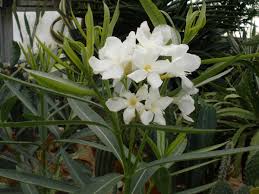.jpeg)
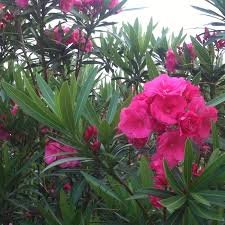.jpeg)
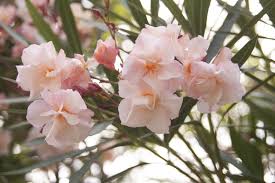.jpeg)
Oleander plants (Nerium oleander) are among the most versatile of shrubs, with dozens of uses in southern and coastal landscapes. They tolerate a wide range of conditions, including difficult soil, salt spray, high pH, severe pruning, reflected heat from pavements and walls, and drought. But the one thing they can’t withstand is winter temperatures below 20 degrees Fahrenheit. However, in cooler climates, you can grow an oleander plant in a container and bring it indoors when temperatures drop.
Oleander flowers are showy, profuse, and often fragrant, which makes them very attractive in many contexts. Over 400 cultivars have been named, with several additional flower colors not found in wild plants having been selected, including yellow, peach and salmon. Many cultivars, like "Hawaii" or "Turner's Carnival", are multi-colored, with brilliant striped corollas.The solid whites, reds and a variety of pinks are the most common. Double flowered cultivars like "Mrs Isadore Dyer" (deep pink), "Mathilde Ferrier" (yellow) or "Mont Blanc" (white) are enjoyed for their large, rose-like blooms and strong fragrance. There is also a variegated form, 'Variegata', featuring leaves striped in yellow and white.Several dwarf cultivars have also been developed, offering a more compact form and size for small spaces. These include "Little Red", "Petite White", "Petite Pink" and "Petite Salmon", which grow to about 8 feet at maturity.
Wel done sir...waiting for ur next valuble post...
Downvoting a post can decrease pending rewards and make it less visible. Common reasons:
Submit
Source
Oleander seeds introduce us to the mysteries of Nature. I would like to tell you about the beauty of oleanders, but also about some of their secrets which are perhaps not so well-known. Let us journey into the distant as well as the more recent past, to get a sense of just how long the oleander has been and is with us on this earth.
In our garden we used often pesticides to rid off mice, flies, caterpillars...The beauty of the oleander in our garden is undoubtably a fact, including the toxicity of this plant. Our oleander plants, which kept multiplying (as seeds were sown every year) served at first to hide the chain-link fences. Later, I kept them in pots. All of the sudden no more mice, hardly any more flies, and caterpillars hadn’t been seen for a long time. Did the toxicity of oleanders have something to do with it? Whatever it was, living with Nature had become much more pleasant.
Source
Although poisonous, this plant family is broadly distributed in cultivation as it contains many especially colorful members. These are sometimes even considered the most beautiful in the plant kingdom. The best-known genera are: Plumeria, Allamanda, Mandevilla, and Nerium.
Animals do not eat the oleander, as all parts taste very bitter and if swallowed will trigger the vomiting reflex. Thus they avoid the plant in the future. In humans, ingesting even a few oleander leaves will cause the following symptoms successively: dizziness, nausea, vomiting, cardiac arhythmia, paralysis, and in the worst-case scenario death through heart failure. Swallowing even one leaf or drinking the flower’s nectar can cause death in children. Oleander extracts were used in the past as arrow poisons, and the bark as rodent poison.
Source
When pruning oleanders, wear gloves; don’t eat or smoke. The poisonous milky sap should not enter open wounds. Oleander wood should not be used as firewood; the smoke can cause painful irritation. Do not rub your eyes. Wash hands with soap after the work is finished.
Source
Downvoting a post can decrease pending rewards and make it less visible. Common reasons:
Submit
Another very interesting post by @ctrl-alt-nwo sir.I am sure you are a true nature lover.Let me find something interesting for you.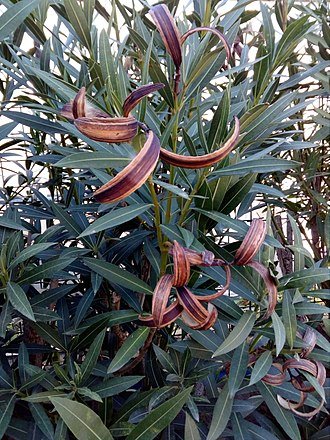
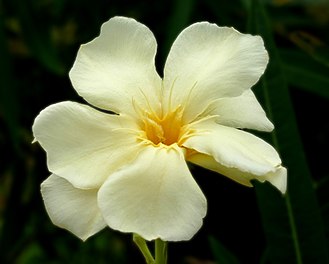.jpg)
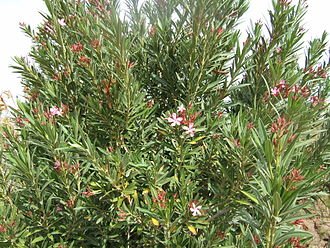
Introduction:
Nerium oleander is a shrub or small tree in the dogbane family Apocynaceae, toxic in all its parts. It is the only species currently classified in the genus Nerium. It is most commonly known as nerium or oleander, from its superficial resemblance to the unrelated olive Olea. It is so widely cultivated that no precise region of origin has been identified, though southwest Asia has been suggested. The ancient city of Volubilis in Morocco may have taken its name from the Berber name oualilt for the flower. Oleander is one of the most poisonous commonly grown garden plants.Oleander grows to 2–6 m (6.6–19.7 ft) tall, with erect stems that splay outward as they mature; first-year stems have a glaucous bloom, while mature stems have a grayish bark. The leaves are in pairs or whorls of three, thick and leathery, dark-green, narrow lanceolate, 5–21 cm (2.0–8.3 in) long and 1–3.5 cm (0.39–1.38 in) broad, and with an entire margin filled with minute reticulate venation web typical to Eudicots. Leaves are light green and very glossy when young, before maturing to a dull dark green/greenish gray. The flowers grow in clusters at the end of each branch; they are white, pink to red, 2.5–5 cm (0.98–1.97 in) diameter, with a deeply 5-lobed fringed corolla round the central corolla tube. They are often, but not always, sweet-scented. The fruit is a long narrow pair of follicles 5–23 cm (2.0–9.1 in) long, which splits open at maturity to release numerous downy seeds.
Ecology:Some invertebrates are known to be unaffected by oleander toxins, and feed on the plants. Caterpillars of the polka-dot wasp moth (Syntomeida epilais) feed specifically on oleanders and survive by eating only the pulp surrounding the leaf-veins, avoiding the fibers. Larvae of the common crow butterfly (Euploea core) also feed on oleanders, and they retain or modify toxins, making them unpalatable to potential predators such as birds, but not to other invertebrates such as spiders and wasps.
The flowers require insect visits to set seed, and seem to be pollinated through a deception mechanism. The showy corolla acts as a potent advertisement to attract pollinators from a distance, but the flowers are nectarless and offer no reward to their visitors. They therefore receive very few visits, as typical of many rewardless flower species. Fears of honey contamination with toxic oleander nectar are therefore unsubstantiated.
Colors and varieties:Oleander flowers are showy, profuse, and often fragrant, which makes them very attractive in many contexts. Over 400 cultivars have been named, with several additional flower colors not found in wild plants having been selected, including yellow, peach and salmon. Many cultivars, like "Hawaii" or "Turner's Carnival", are multi-colored, with brilliant striped corollas.[29] The solid whites, reds and a variety of pinks are the most common. Double flowered cultivars like "Mrs Isadore Dyer" (deep pink), "Mathilde Ferrier" (yellow) or "Mont Blanc" (white) are enjoyed for their large, rose-like blooms and strong fragrance. There is also a variegated form, 'Variegata', featuring leaves striped in yellow and white. Several dwarf cultivars have also been developed, offering a more compact form and size for small spaces. These include "Little Red", "Petite White", "Petite Pink" and "Petite Salmon", which grow to about 8 feet at maturity.
Cultivation history:Nerium oleander has a history of cultivation going back millennia, especially amongst the great ancient civilizations of the Mediterranean Basin. Some scholars believe it to be the rhodon (rose), also called the 'Rose of Jericho', mentioned in the Bible (Ecclesiastes XXIV, 13) dating back to between 450 and 180 BC. This is because no form of the traditional rose occurs in the wild in Palestine, but pink-flowering Oleander is common throughout the region.
The ancient Greeks had several names for the plant, including rhododaphne, nerion, rhododendron and rhodon.[56] Pliny confirmed that the Romans had no Latin word for the plant, but used the Greek terms instead.
Toxicity:Oleander has historically been considered a poisonous plant because some of its compounds may exhibit toxicity, especially to animals, when consumed in large amounts. Among these compounds are oleandrin and oleandrigenin, known as cardiac glycosides, which are known to have a narrow therapeutic index and can be toxic when ingested.
Toxicity studies of animals administered oleander extract concluded that rodents and birds were observed to be relatively insensitive to oleander cardiac glycosides. Other mammals, however, such as dogs and humans, are relatively sensitive to the effects of cardiac glycosides and the clinical manifestations of "glycoside intoxication".
Effects of poisoning:Ingestion of this plant can affect the gastrointestinal system, the heart, and the central nervous system. The gastrointestinal effects can consist of nausea and vomiting, excess salivation, abdominal pain, diarrhea that may contain blood, and especially in horses, colic. Cardiac reactions consist of irregular heart rate, sometimes characterized by a racing heart at first that then slows to below normal further along in the reaction. Extremities may become pale and cold due to poor or irregular circulation. The effect on the central nervous system may show itself in symptoms such as drowsiness, tremors or shaking of the muscles, seizures, collapse, and even coma that can lead to death.
Oleander sap can cause skin irritations, severe eye inflammation and irritation, and allergic reactions characterized by dermatitis.
Treatment:Poisoning and reactions to oleander plants are evident quickly, requiring immediate medical care in suspected or known poisonings of both humans and animals. Induced vomiting and gastric lavage are protective measures to reduce absorption of the toxic compounds. Charcoal may also be administered to help adsorb any remaining toxins. Further medical attention may be required depending on the severity of the poisoning and symptoms. Temporary cardiac pacing will be required in many cases (usually for a few days) until the toxin is excreted.
Digoxin immune fab is the best way to cure an oleander poisoning if inducing vomiting has no or minimal success, although it is usually used only for life-threatening conditions due to side effects
Drying of plant materials does not eliminate the toxins. It is also hazardous for animals such as sheep, horses, cattle, and other grazing animals, with as little as 100 g being enough to kill an adult horse. Plant clippings are especially dangerous to horses, as they are sweet. In July 2009, several horses were poisoned in this manner from the leaves of the plant. Symptoms of a poisoned horse include severe diarrhea and abnormal heartbeat. There is a wide range of toxins and secondary compounds within oleander, and care should be taken around this plant due to its toxic nature. Different names for oleander are used around the world in different locations, so, when encountering a plant with this appearance, regardless of the name used for it, one should exercise great care and caution to avoid ingestion of any part of the plant, including its sap and dried leaves or twigs. The dried or fresh branches should not be used for spearing food, for preparing a cooking fire, or as a food skewer. Many of the oleander relatives, such as the desert rose (Adenium obesum) found in East Africa, have similar leaves and flowers and are equally toxic.
It's a beautiful yet dangerous flower.Keeping safe distance is adviced.Thanks for the post.@upvoted
Downvoting a post can decrease pending rewards and make it less visible. Common reasons:
Submit
Oleander (Nerium oleander) is a plant of the genus Zakkumgiller. It is also known as the flower of hell that grows in warm regions and loves warmth. along the coastline of the Mediterranean region, while Turkey is grown in West and South.
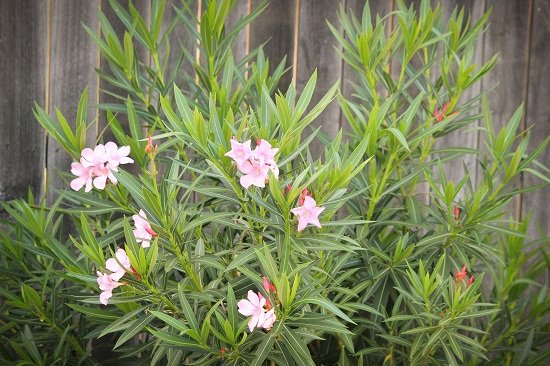



§§§§§§§§§§§§§§§§§§§§§§§§§§§§§§§§§§§§§§§§§§§§§§§§§§§§§§§§§§§§§§§
§§§§§§§§§§§§§§§§§§§§§§§§§§§§§§§§§§§§§§§§§§§§§§§§§§§§§§§§§§§§§§§
Its length can usually be 2-3 meters, sometimes up to 5 meters. It is a common tree with no leaves in winter. It grows naturally in parks and gardens, as ornamental plants. There are beautiful flowers in red or pink color.
§§§§§§§§§§§§§§§§§§§§§§§§§§§§§§§§§§§§§§§§§§§§§§§§§§§§§§§§§§§§§§§
§§§§§§§§§§§§§§§§§§§§§§§§§§§§§§§§§§§§§§§§§§§§§§§§§§§§§§§§§§§§§§§
Oleander is a poisonous plant. Leaves contain resin, glucose, tannin, vitamin C and a glycoside called oleandrin. Its shells contain volatile and fixed oils, a resinous compound and glycosides. Seeds also contain many glycosides. It is very toxic and should be kept away from children's leaves. Even when 1 gram of leaf is defeated, it can lead to significant poisoning.
§§§§§§§§§§§§§§§§§§§§§§§§§§§§§§§§§§§§§§§§§§§§§§§§§§§§§§§§§§§§§§§
§§§§§§§§§§§§§§§§§§§§§§§§§§§§§§§§§§§§§§§§§§§§§§§§§§§§§§§§§§§§§§§
§§§§§§§§§§§§§§§§§§§§§§§§§§§§§§§§§§§§§§§§§§§§§§§§§§§§§§§§§§§§§§§
Downvoting a post can decrease pending rewards and make it less visible. Common reasons:
Submit
Whilst in greece i took several cuttings of Nerium Oleander.
These survived the journey home in my suitcase and i am attempting to root these in water....this should take around 3 to 4 weeks then I can pot them up as a holiday momento 💖💔
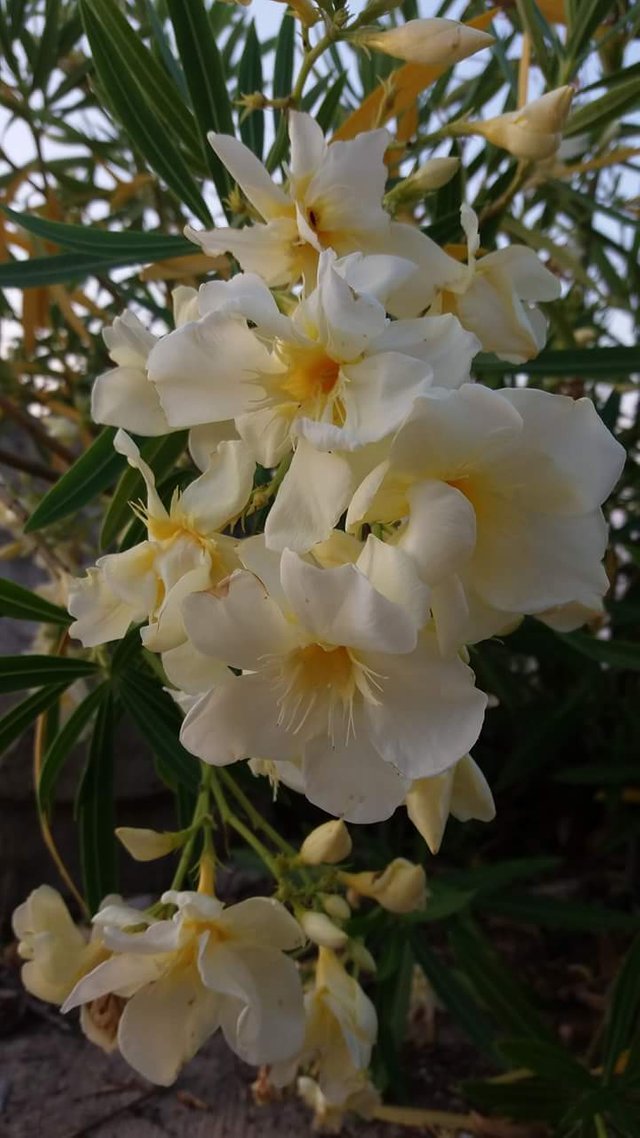
The cuttings have been stripped of lower leaves and the top most softer tips removed to prevent wilting. .
Beautiful lemon yellow Nerium oleander found at limonari beach meganisi
placed in water in the grey container
The cuttings stripped of lower leaves
Downvoting a post can decrease pending rewards and make it less visible. Common reasons:
Submit
The oleander tree is bushy one and reaches up to 10-12 ft in height. It has small stem with multiple branches and each branch has three pair of 6-8 inch long leaves. Those leaves are completely green, smooth, shiny even rough. Oleander flowers are found in different shades like pale pink, dark pink, red, white and yellow even. The trees are grown in temples, gardens, parks and also used as the ornamental plant. It bears flowers throughout the year; while the yellow oleander gives the illusion of having spring and rainy season at the same time.
10 Health benefits of Oleander-
Downvoting a post can decrease pending rewards and make it less visible. Common reasons:
Submit
Nerium oleander is a highly toxic ornamental shrub widely cultivated in the Mediterranean. It has been grown since ancient times and features in many of the Roman wall paintings in Pompeii.
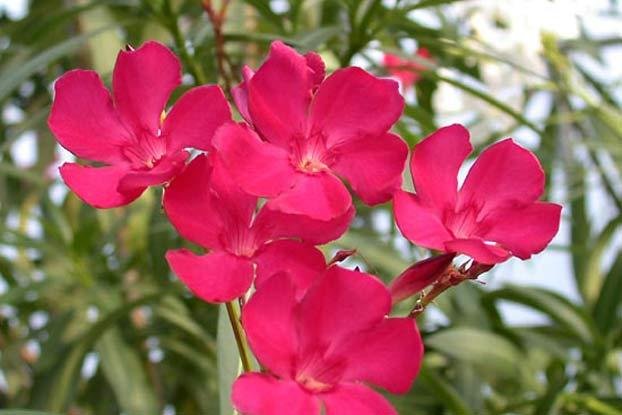
An evergreen shrub (or small tree) that grows to approximately 6 m. A sticky latex is exuded if the stem is cut.The flowers are tubular with five lobes, red or pink in the wild, but may be white, cream, yellow or purple in cultivars, and double forms have also been selected. Some are scented.
Medicinal:
Oleandrin is used for treating cardiac conditions in patients who cannot tolerate digitalis. In traditional medicine, the leaves have been used for a variety of medicinal purposes, including the treatment of heart diseases, as a diuretic, antibacterial, and against snake-bite.The roots have been used externally in traditional medicine for treating cancer, ulcers and leprosy.
Cultivation:
A tender plant, Nerium oleander can survive light frosts, but show signs of frost damage. It is a common landscape plant in tropical and subtropical climates and grows in a wide range of soils. It can withstand drought and salt spray, being widely used in coastal areas, and reacts well to full sun or partial shade. The species can be propagated by semi-ripened cuttings in summer or seeds. Hard pruning helps to maintain its shape.
Nerium oleander illustration - Painting of Nerium oleander by Marianne North
Source
Thanks for reading @ctrl-alt-nwo
Downvoting a post can decrease pending rewards and make it less visible. Common reasons:
Submit
Magoo-2 found a series of multi accounts of a same owner is following your articles to cheat your generous rewards.
Magoo-2 found these accounts are suspicious & can be multi accounts of a single owner. Conclusion is based on last 30 days transactions:
@dangerux
@cointurk
@thegossip
@bburak30
@embesilikat
@kagantrky
@amalinavia
@gesund
@kksafak
@bado
@fkorkmaz
@bahriyeli
@ygmraykt
@ucmuharfli
@mertkrtsss
@curious4
@alkmaar
magoo-2
Check our latest multi comment spam update report
Downvoting a post can decrease pending rewards and make it less visible. Common reasons:
Submit
Hey @magoo-2
I don't know this account!!!
I don't use multi account
You can't blame me!!!!!
Downvoting a post can decrease pending rewards and make it less visible. Common reasons:
Submit
Oleander can be found throughout the world in tropical and subtropical locations. It's originally from Asia, but has become a popular landscape plant in warm climates of North America. The reason for its popularity is the beautiful clusters of flowers that grow at the end of each branch. It's also hardy and drought tolerant.
If eaten, the poisonous effects of this plant can be felt almost immediately. It targets the gastrointestinal and cardiac systems with symptoms of blurred vision, irregular heartbeat, nausea, vomiting, drooling, and bloody diarrhea. Every single part of this plant is poisonous. There have even been cases of people being poisoned by inhaling the smoke from burning oleander.
Downvoting a post can decrease pending rewards and make it less visible. Common reasons:
Submit
Botanical Information: From Zakkumgiller family; It is a plant that grows up to 5 meters in height. It does not shed its leaves in winter months. It's often branched. The flowers are pink. Fruit is in the form of capsules, poisonous. It should not be used in home remedies.
Cultivated Places: It grows in our dominant lands of Mediterranean climate.
Known Composition: The leaves have resin, tannin, glucose, vitamin C and a glycoside called oleandrin. Shells and seeds also have effective ingredients.
Benefits:
If used externally, the muscle will relieve the pain. Scorpion and bee sting is useful. If it is used in low doses, it strengthens the heart, it excretes urine in abundant quantities. Empty the water that accumulates in the body.
WARNING: It is poisonous and should be used with caution.
Downvoting a post can decrease pending rewards and make it less visible. Common reasons:
Submit
All About the Oleander Flower
The oleander is an ornamental plant that is used throughout the world as a great flower for decorations and such. There are a lot of people that know the oleander well and grow it so that they can use it in bouquets. However, this is a poisonous flower, so it is very important to understand how this flower works, what it looks like, and how you should handle it, this way you are prepare with the toxic poison that it can put forward. This is probably way the oleander has a floral meaning of caution; it is very suited for how dangerous that this flower can be even in small amounts.
Description of the Oliner flower
Oleander is indeed part of a evergreen neat that is called dogbane family. This plant is extremely toxic, in fact all parts of the plant are poisonous, so it is very important to be almost careful. It is indeed one of the most toxic plants which is grown in the common people garden, and for this reason, it is very important to see the people and animals around. In the right quantities, you can actually make yourself a lot of damage with this plant itself. It is a plant that is tall and can grow up to 20 feet tall. In the first year, the plant looks different from the following years and there is increase in the tree at the branches. You will find that this flower can be red, pink, and white.
Use for oleander flowers
Since Olidder is poisonous, people are very careful with him. However, this flower is beautiful and for that reason you will see it arranged a lot. People should take precautions if they were going to use it in the bauxite because they can spread poisonous material easily but, for other people, it is a plant that they prefer to use for natural scenes. You will find it in many areas to take care of landscapes where many areas and animals do not use it. It is a plant that is alerted about you as long as it looks great and it is a great fit for landscapes and fountains. Check out the oleander you are looking for the landscape and really have a great looking area.
Why do people feel like Olinar Flower?
You'll find the whole native oleander in Morocco, Portugal, and the Mediterranean regions. It is also found throughout China and Asia. Although this plant wants to stretch around the dry bed and actually likes more tropical and subtropical areas, but it can be found in nature as North Carolina as North Korea. In the case of farming, these flowers are used throughout the United States for planting medial strip. If you're going to increase it in the cold areas, you're going to use a greenhouse or you're going to want to keep it as an indoor plant
Downvoting a post can decrease pending rewards and make it less visible. Common reasons:
Submit
This lovely Mediterranean bush isn't solid in our general vicinity, yet is much of the time utilized as a holder plant for summer porches. Developing to 10 feet or more in a holder, the oleander (Nerium oleander) is frequently prepared as a standard or with a plaited trunk. The spear formed weathered leaves take after the leaves of the olive tree (Olea), in this way the species name.
White, red, pink, salmon, and light yellow-blossomed assortments sprout all mid year when arranged in a bright area outside. The oleander is utilized like Crepe Myrtles in southern Florida, lining boulevards, for supports, or as garden examples. It can be kept over the winter in a bright window inside, despite the fact that it will most likely shed a lot of its foliage. Give as cool a spot as could be allowed. Keep soil clammy while outside in sun, yet enable the dirt to dry tolerably inside finished the winter.
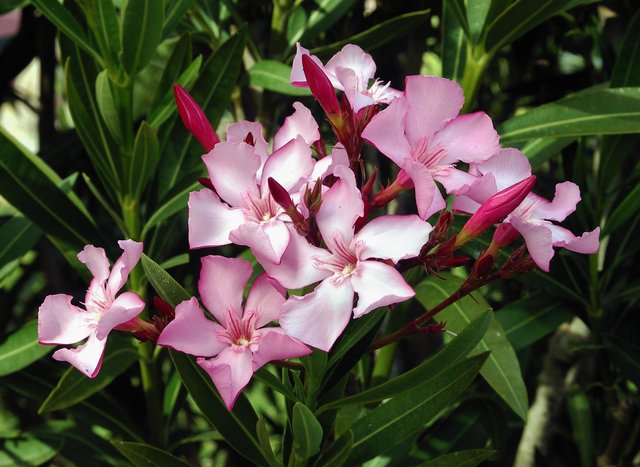
One disadvantage to this lovely plant is its danger to people and different warm blooded creatures. All parts are poisonous if ingested, and contact with the sap may cause dermatitis. My mom used to recount the narrative of her school companion who endured an extreme response to the smoke from a campfire on which branches of oleander had been set. There have been not very many revealed incidental passings from Nerium oleander, however munching dairy cattle and stallions have been known to bite the dust from expending an excessive number of clears out. The plant ought to be kept from the compass of little kids or biting pets.
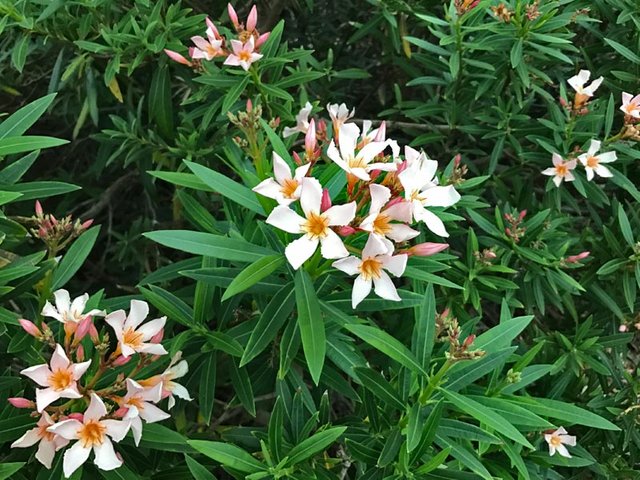
Downvoting a post can decrease pending rewards and make it less visible. Common reasons:
Submit
magoo-2 found a series of multi accounts of a same owner is following your articles to cheat your generous rewards.
magoo-2 found these accounts are suspicious & can be multi accounts of a single owner. Conclusion is based on last 30 days transactions:
@rik432, @ratul8940, @rahul72, @taylor10, @villani, @wilson6, @masud90, @purepinag, @sumonsha, @perry1, @max1994
magoo-2
Check our latest multi comment spam update report
Downvoting a post can decrease pending rewards and make it less visible. Common reasons:
Submit
oleander
Oleander can be found throughout the world in tropical and subtropical locations. It's originally from Asia, but has become a popular landscape plant in warm climates of North America. The reason for its popularity is the beautiful clusters of flowers that grow at the end of each branch. It's also hardy and drought tolerant.
If eaten, the poisonous effects of this plant can be felt almost immediately. It targets the gastrointestinal and cardiac systems with symptoms of blurred vision, irregular heartbeat, nausea, vomiting, drooling, and bloody diarrhea. Every single part of this plant is poisonous. There have even been cases of people being poisoned by inhaling the smoke from burning oleander.

Downvoting a post can decrease pending rewards and make it less visible. Common reasons:
Submit
magoo-2 found a series of multi accounts of a same owner is following your articles to cheat your generous rewards.
magoo-2 found these accounts are suspicious & can be multi accounts of a single owner. Conclusion is based on last 30 days transactions:
@rik432, @ratul8940, @rahul72, @taylor10, @villani, @wilson6, @masud90, @purepinag, @sumonsha, @perry1, @max1994
magoo-2
Check our latest multi comment spam update report
Downvoting a post can decrease pending rewards and make it less visible. Common reasons:
Submit
Oleanders have long, narrow, dark green leaves that are typically four to six inches long and less than an inch wide. The showy flowers are either single or double and range from white through yellow, peach, salmon and pink to deep burgundy red. They flower from summer to fall. Oleanders are drought tolerant and will even tolerate salty spray, making them useful for planting near the ocean. They are hardy in USDA zones 8 through 10, although they occasionally get frost bit in zone 8 and die back to the roots. They come back the next spring, however.
Given how poisonous oleanders are, you may be wondering why anyone would plant them. They are drought and sea salt tolerant so are often planted along highways in beautification projects.They grow quickly, one to two feet a year, and can quickly become a thick hedge or a small tree. Most oleanders grow to be between eight and 12 feet tall and just as wide. Dwarf varieties stay three to five feet tall and just as wide. Occasionally, a protected tree may reach 20 feet. Their showy blossoms make them an ideal accent piece in the garden
Downvoting a post can decrease pending rewards and make it less visible. Common reasons:
Submit
Downvoting a post can decrease pending rewards and make it less visible. Common reasons:
Submit
Oleander is an ornamental shrub with attractive characteristics from flower to stems. The plant is an erect evergreen shrub with lovely flower clusters of pink flowers. Each flower has 5 spreading petals.The flower clusters are supported by the plant’s slender stems. Lance-shaped with leathery texture and pointed tips refer to the plant’s leaves.
If the flowers come in clusters, the leaves come in groups of 2 or 3 along the branch.
Oleanders are so well known to both northern and southern gardeners, they need little introduction or description.They are grown everywhere in the South, and at one time ranked with hydrangeas as northern house plants. For some obscure reasons, oleanders faded from popularity some years ago, but they are now making quite a comeback. Give these plants well-drained soil, full light, and plenty of fresh air.
Lot of various Olenders plants has around the world. Thanks.
Downvoting a post can decrease pending rewards and make it less visible. Common reasons:
Submit
The oleander, or Nerium oleander, is considered by numerous to be the most harmful plant on the planet. All parts of the wonderful oleander contain harm - a few kinds of toxic substance. Two of the most strong are oleandrin and neriine, known for their capable impact on the heart. An oleander's toxic substance is so solid, truth be told, that it can harm a man who essentially eats the nectar made by honey bees that have processed oleander nectar.
The oleander is an appealing plant, and in spite of its lethal notoriety is frequently planted for brightening purposes. Albeit local to the Far East and the Mediterranean zones, oleander has been presented in the United States, where it develops effectively. It's tolerant of low quality soil and dry climate. The plant develops as a thick bush, and is normally 6 to 18 feet (1.8 to 5.4 meters) tall at development. It has thick, dim green leaves, and the blossoms, which develop in bunches, can be yellow, red, pink or white.
Indeed, even in infertile regions, the oleander creates dazzling blooms and aroma. Creatures naturally maintain a strategic distance from the plant, and it develops quickly, so it's regularly utilized for interstate boundaries and different regions that require screening from commotion and contamination. Its quick development additionally settles on it a prominent decision around new development zones, as it avoids disintegration.
Dissimilar to some harmful plants, the oleander is noxious to most creatures and in addition people. A solitary ingested oleander leaf can murder a youngster. Ingestion of oleander brings about the runs, spewing, extreme stomach torment, sluggishness, tipsiness, a sporadic pulse, and regularly, passing. On the off chance that the casualty survives the underlying 24 hours after ingestion, his or her chances of surviving increment drastically. For effective treatment, the patient is instigated to regurgitation, his or her stomach might be pumped, or he or she might be encouraged actuated charcoal to retain however much of the toxin as could be expected.
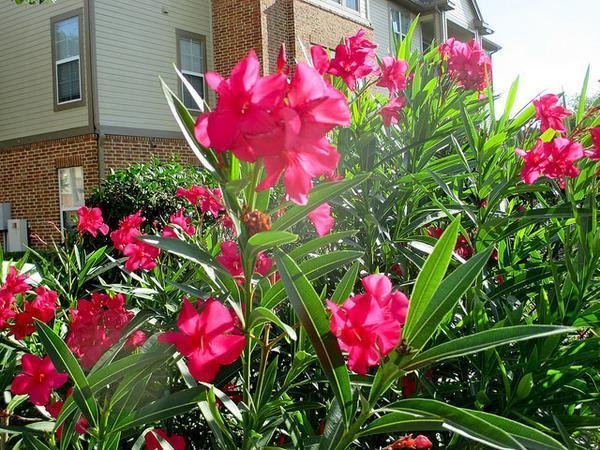
Downvoting a post can decrease pending rewards and make it less visible. Common reasons:
Submit
Although the oleander plant is a stylish plant with its general characteristics, it is poisonous which causes it to be separated from other ornamental plants. The most common type of oleander with different flower colors are those with pink flowers. In addition to flowers and leaves, oleander, which also gives fruit in the form of pods, is a plant that poisons when poisonous parts are used. The most important varieties of oleander are the oleander flowers and red layered flowers, which are large white flowers. In order to grow any of the oleander varieties as ornamental plants, it is possible to grow the oleander sprout taken during the summer months by sprinkling in water for a while.
Click for photo
What are the features of Zakkumun?
Although oleander is very beautiful and attractive, it is poisonous, which makes it necessary for the oleander to grow in the houses. A cinstir that grows up to 5 meters in length when grown up in wetlands and grows even more efficiently when truncated. Furthermore, the fact that the plant is selective in terms of soil causes the oleander to be suitable for growing everywhere. Resistance to the cold even in the winter is resistant to the fact that the oleander grows in all seasons in a sheltered manner. It is a plant that loves sunny air and does not want fertilizer in the soil to grow efficiently. However, if the oleander is grown in the pot, it is beneficial to mix some amount of sheep grape.
Click for photo
What are the Benefits of Zakkumun?
If it is a poisonous plant with branches and flowers, it does not mean that zakkacum will not be beneficial. When used within the doctor's proposal and control, it is extremely beneficial for health. First of all, it is a beneficial herb when it is externally applied against skin diseases, as well as the potency enhancer effect. Diuretic properties and the treatment of heart conditions are among the main benefits. In addition, researches on oleander have been found to be effective even in cancer. Especially for patients with skin cancer, it is recommended to use natural medicines derived from oleander seed extract. The use of Zakkum for health should be after the dried form. The oleander plant, which is recommended to be used by boiling, is externally used for diseases on the skin, and it is recommended by experts to use it by mixing with olive oil.
Click for photo
Downvoting a post can decrease pending rewards and make it less visible. Common reasons:
Submit
@ctrl-alt-nwo Nerium oleander wonderful plant.
Description:;
Nerium oleander is a shrub or small tree in the dogbane family Apocynaceae, toxic in all its parts. It is the only species currently classified in the genus Nerium. It is most commonly known as nerium or oleander, from its superficial resemblance to the unrelated olive Olea. It is so widely cultivated that no precise region of origin has been identified, though southwest Asia has been suggested. The ancient city of Volubilis in Morocco may have taken its name from the Berber name oualilt for the flower. Oleander is one of the most poisonous commonly grown garden plants.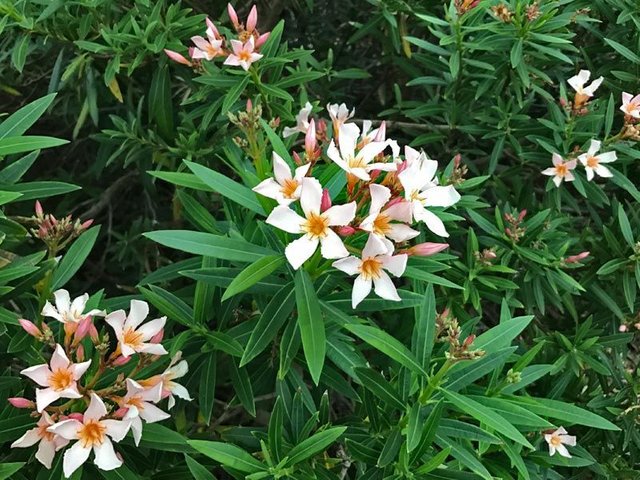
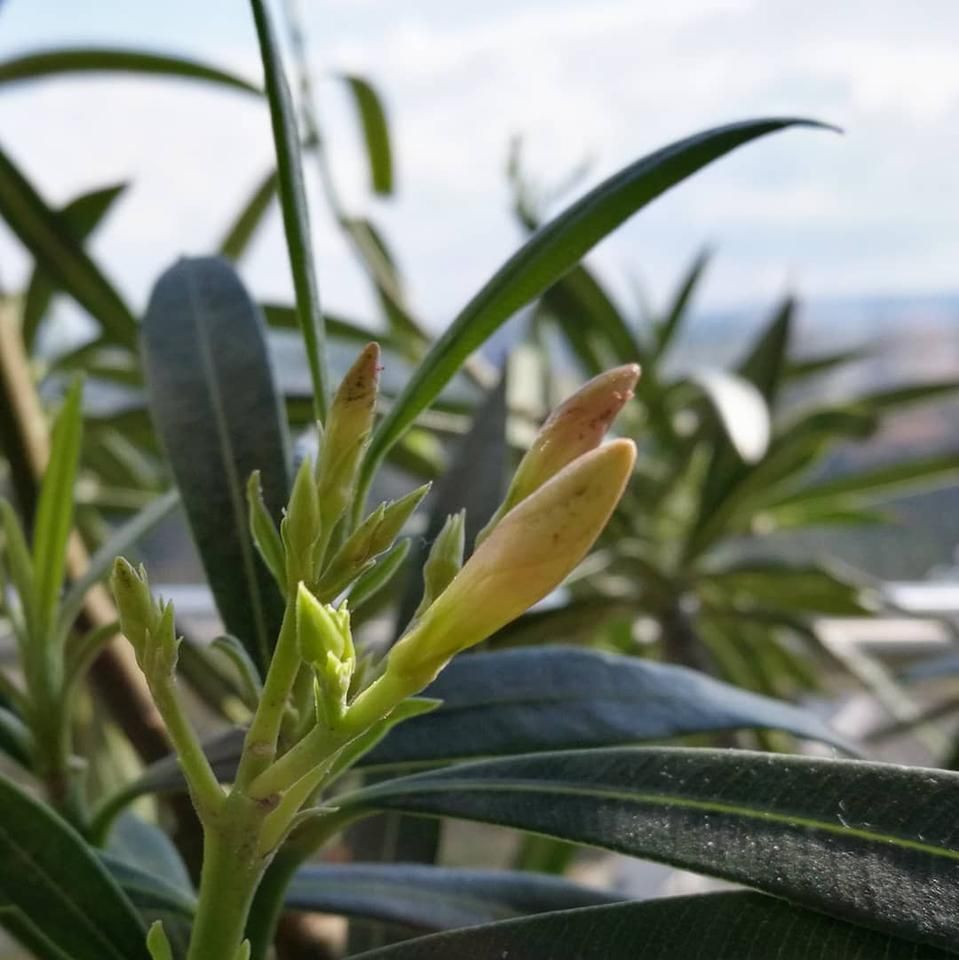
Oleander grows to 2–6 m (6.6–19.7 ft) tall, with erect stems that splay outward as they mature; first-year stems have a glaucous bloom, while mature stems have a grayish bark. The leaves are in pairs or whorls of three, thick and leathery, dark-green, narrow lanceolate, 5–21 cm (2.0–8.3 in) long and 1–3.5 cm (0.39–1.38 in) broad, and with an entire margin filled with minute reticulate venation web typical to Eudicots. Leaves are light green and very glossy when young, before maturing to a dull dark green/greenish gray. The flowers grow in clusters at the end of each branch; they are white, pink to red,[Note 2] 2.5–5 cm (0.98–1.97 in) diameter, with a deeply 5-lobed fringed corolla round the central corolla tube. They are often, but not always, sweet-scented.[Note 3] The fruit is a long narrow pair of follicles 5–23 cm (2.0–9.1 in) long, which splits open at maturity to release numerous downy seeds.
 .
.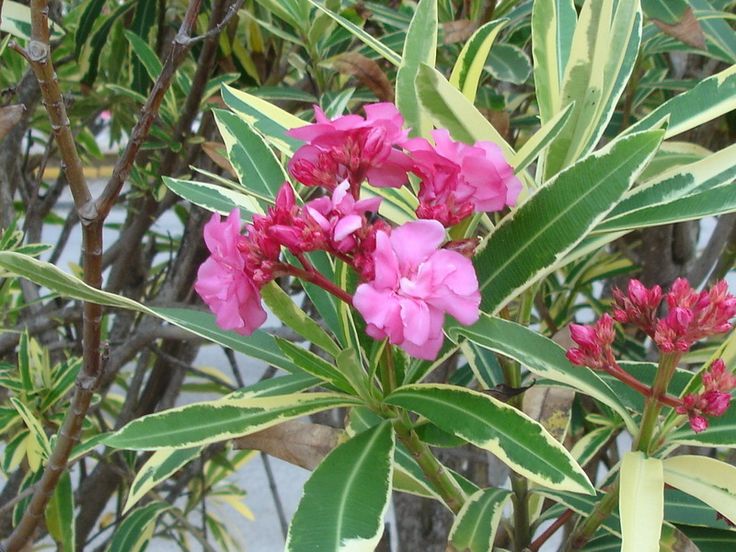
Downvoting a post can decrease pending rewards and make it less visible. Common reasons:
Submit
magoo-2 found a series of multi accounts of a same owner is following your articles to cheat your generous rewards.
magoo-2 found these accounts are suspicious & can be multi accounts of a single owner. Conclusion is based on last 30 days transactions:
@rik432, @ratul8940, @rahul72, @taylor10, @villani, @wilson6, @masud90, @purepinag, @sumonsha, @perry1, @max1994
magoo-2
Check our latest multi comment spam update report
Downvoting a post can decrease pending rewards and make it less visible. Common reasons:
Submit
This very beautiful garden and beautiful photography
thanks @ctrl-alt-nwo
Have a great day.
Downvoting a post can decrease pending rewards and make it less visible. Common reasons:
Submit
The oleander is a shrub typical of the Mediterranean where it grows naturally but it is also cultivated for ornamental purposes.



In the flowering period it is easy to see this beautiful flowering plant along the roads or in home gardens, in urban parks or in the countryside, especially along rivers and near the sea. This plant will grow healthy and strong especially in the Mediterranean where he finds a perfect climate for its cultivation and does not like the cold weather.
Oleander in the countryside, Sardinia (Italy)
But the great looks should not be fooled: the oleander is in fact one of the most toxic plants that are known. The whole plant is toxic to any animal species and ingesting oleander parties may also lead to death.
It is said that several soldiers of Napoleon's troops died from poisoning after using oleander branches as skewers for cooking meat on the grill during the military campaigns in Italy.
The film "White Oleander" played by actress Michelle Pfeiffer tells the story of a woman who kills her lover through the white oleander extract
Downvoting a post can decrease pending rewards and make it less visible. Common reasons:
Submit
magoo-2 found a series of multi accounts of a same owner is following your articles to cheat your generous rewards.
magoo-2 found these accounts are suspicious & can be multi accounts of a single owner. Conclusion is based on last 30 days transactions:
@moniristi, @shishiristi
magoo-2
Check our latest multi comment spam update report
Downvoting a post can decrease pending rewards and make it less visible. Common reasons:
Submit
Yes, I heard about this plant. It's beautiful though, but I would not risk growing it. All parts of the plant are poisonous, which is associated with the content in them of oleandrin, cornerine and other cardiac glycosides. Oleander juice, ingested, causes severe colic in humans and animals, vomiting and diarrhea, and then leads to serious problems in the activity of the heart and central nervous system. The cardiac glycosides contained in it can cause cardiac arrest. In connection with the poisonousness of the plant, it is not recommended to place it in children's institutions.Thanks for the useful information .
http://www.terraforma.ae/shop/product/nerium-oleander-oleander/
Downvoting a post can decrease pending rewards and make it less visible. Common reasons:
Submit
Oleander Is a Dangerous Beauty
How can some of the most beautiful plants be so toxic? Take oleander—that wonderfully large shrub that, despite high winds and salt spray along our coastlines, somehow manages to produce clusters of gorgeous blooms in summer in white, yellow, peach, salmon, pink or red. And yet oleander is considered one of the most poisonous plants in the world. All parts of this gracefully mounded shrub contain poison; a single leaf ingested by a child is known to be deadly.
But, as with thorny roses, prickly cacti, and toxic holiday plants, knowledge is key in preventing hazardous encounters with these landscape beauties. Native to the Far East and the Mediterranean, oleanders, Nerium oleander, grow easily—and rapidly—in the United States, especially southern coastal climes, where they’re often planted along highways as a noise and pollution barrier. These evergreens thrive with little care and are very tolerant of heat and drought. Most will survive temperatures as low as 15 to 20 degrees, though their foliage may get damaged. Yet even then, the shrubs recover quickly in spring so long as their roots are not harmed.
Oleanders grow best in full sun, and most reach 8 to 15 feet tall and as wide, so make sure you give these big guys plenty of space in the landscape. They flower from early summer until mid-autumn with large clusters of 2-inch single or double blossoms. Their long, narrow leaves are smooth but leathery.
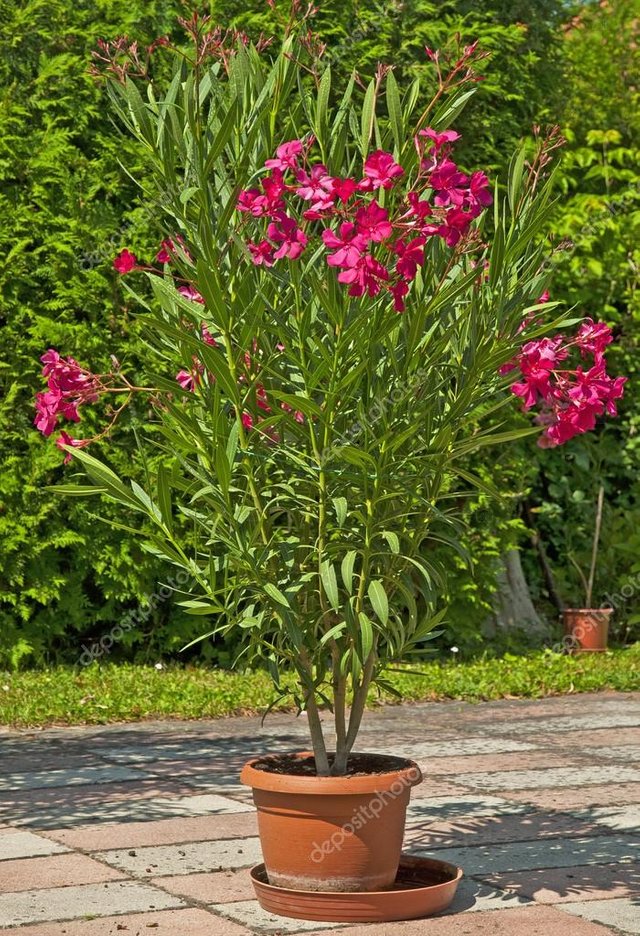
A few cultivars to consider include:
'Algiers' features single, dark red flowers.
‘Calypso’ is cold hardy with cherry red single flowers.
‘Hardy Red' is extremely cold hardy with deep red single blooms.
‘Petite Salmon’ is a dwarf plant but less cold hardy than most oleanders.
‘Sister Agnes’ is hardy, grows to 12 feet and has large single white flowers.
Downvoting a post can decrease pending rewards and make it less visible. Common reasons:
Submit
magoo-2 found a series of multi accounts of a same owner is following your articles to cheat your generous rewards.
magoo-2 found these accounts are suspicious & can be multi accounts of a single owner. Conclusion is based on last 30 days transactions:
@rik432, @ratul8940, @rahul72, @taylor10, @villani, @wilson6, @masud90, @purepinag, @sumonsha, @perry1, @max1994
magoo-2
Check our latest multi comment spam update report
Downvoting a post can decrease pending rewards and make it less visible. Common reasons:
Submit
Thanks for the info !
Downvoting a post can decrease pending rewards and make it less visible. Common reasons:
Submit
@ctrl-alt-nwo, check you my last 30 day transaction


 !
!
No one should trust anyone based on a false grave. @sumonsha was my school friend. first time transfer him some SBD because i was no any bittrex and blocktrades account.in came to steemit in his heart.
I don't know another id.
I think @perry @villani @taylor and other phillipines girl..
I'm #Bangladeshi girl.বাংলাদেশে আমি থাকি.
If anyone can prove that I have taken use anyone comment copy/paste, then I will not use steemit.
Downvoting a post can decrease pending rewards and make it less visible. Common reasons:
Submit
@ masud90 to @ rik432 $ transfered.
Transfer from @purepinag to
@sumonsha.
@masud90 has the link to @rik432 with
this id. This is understandable. And
@masud90, @purepinag and @sumonsha
interact with each other at the comment.
One of the owners of all these IDs. Be
careful. This guy is very clever. One day
of police's 10 days of thief. do not forget.
Downvoting a post can decrease pending rewards and make it less visible. Common reasons:
Submit
@sumonsha is my friend.
I don't know @masud90.
You are s theif @magoo-2
Downvoting a post can decrease pending rewards and make it less visible. Common reasons:
Submit
If the thief is caught and stolen, he has
many such things. You're lying. I'm
checking all your ID's wallet. I did not say
these things. @purepinag
Downvoting a post can decrease pending rewards and make it less visible. Common reasons:
Submit
You are a layer

Original @magoo say you are a spammer.
Downvoting a post can decrease pending rewards and make it less visible. Common reasons:
Submit
Known in ancient texts as “the desert rose,” historical references show that 15th century B.C. Mesopotamians trusted in the healing benefits of oleander extracts. From a remedy for hangovers to a herb studied for cancer, the Babylonians, Romans, Arabs and ancient Greeks alike used this herbal extract for a variety of health concerns.
Oleander, also known as laurier rose, dogbane and rosebay, is native to the Western Himalayas. It is an incredibly hardy, adaptable plant which grows thick and green in mountainous climates.
Quickly growing, this plant bears clusters of lovely pinkish-white and red flowers in the spring time. Traditionally, oleander leaf has been used to treat a number of health conditions. If you live in the southern United States, chances are you or your neighbors may have some growing in the yard.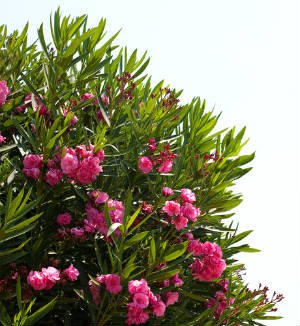
Downvoting a post can decrease pending rewards and make it less visible. Common reasons:
Submit
The oleander is an evergreen and blossoming bush that can grow up to 3 metres, if you let it grow. The leathery leaves come in a lance-like form and can grow up to 15 cm. The oleander’s blossoms grow in clusters, while single blossoms are three to five centimetres in diameter. Most blossoms are available in white, different rose colours, or reds and they can appear throughout the whole year, or in colder regions starting in May. By now, you can not only get the original kinds with unfilled blossoms, but also hybrids with filled ones.
If you have a warm climate you can plant oleander in your garden during the spring. Since most plants’ winter hardiness is not enough in our realms, they can only be planted and exist outside in viticultural areas during the colder months. For this purpose you should only choose kinds that are more frost-resistant and have unfilled blossoms.
https://www.plantopedia.com/nerium-oleander/
Downvoting a post can decrease pending rewards and make it less visible. Common reasons:
Submit
its looking just awesome flower,,Oleander is just a great looking,,thanks for sharing
Downvoting a post can decrease pending rewards and make it less visible. Common reasons:
Submit
Magoo-2 found a series of multi accounts of a same owner is following your articles to cheat your generous rewards.
Magoo-2 found these accounts are suspicious & can be multi accounts of a single owner. Conclusion is based on last 30 days transactions:
@rahmanmdriad
@mdriadrahman26
magoo-2
Check our latest multi comment spam update report
Downvoting a post can decrease pending rewards and make it less visible. Common reasons:
Submit
wow,,its really great flower,,i love this very much,,thanks a lot sir for your sharing special Oleander post,,
Downvoting a post can decrease pending rewards and make it less visible. Common reasons:
Submit
Magoo-2 found a series of multi accounts of a same owner is following your articles to cheat your generous rewards.
Magoo-2 found these accounts are suspicious & can be multi accounts of a single owner. Conclusion is based on last 30 days transactions:
@rahmanmdriad
@mdriadrahman26
magoo-2
Check our latest multi comment spam update report
Downvoting a post can decrease pending rewards and make it less visible. Common reasons:
Submit
hi dear,,
Oleander which looking so amazing,,thanks for sharing
Downvoting a post can decrease pending rewards and make it less visible. Common reasons:
Submit
Ya it's good plant for environment. It has long green leafs and nice flowers too .
Thanks
Downvoting a post can decrease pending rewards and make it less visible. Common reasons:
Submit
Another wonderful post by @ctrl-alt-nwo sir...
Nerium oleander is a shrub or small tree in the dogbane family Apocynaceae, toxic in all its parts. It is the only species currently classified in the genus Nerium. It is most commonly known as nerium or oleander, from its superficial resemblance to the unrelated olive Olea. It is so widely cultivated that no precise region of origin has been identified, though southwest Asia has been suggested. The ancient city of Volubilis in Morocco may have taken its name from the Berber name oualilt for the flower.Oleander is one of the most poisonous commonly grown garden plants.
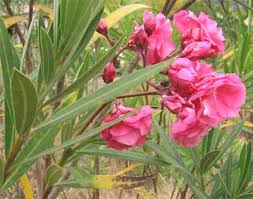.jpeg)
Scientific classification...
5 Order: Gentianales
Wel done and perfect work sir...
Downvoting a post can decrease pending rewards and make it less visible. Common reasons:
Submit
Wow amazing & beautiful tomatoes garden.
For your post propagation.
Upvote/Resteem
Downvoting a post can decrease pending rewards and make it less visible. Common reasons:
Submit
So beautiful garden, thanks for sharing
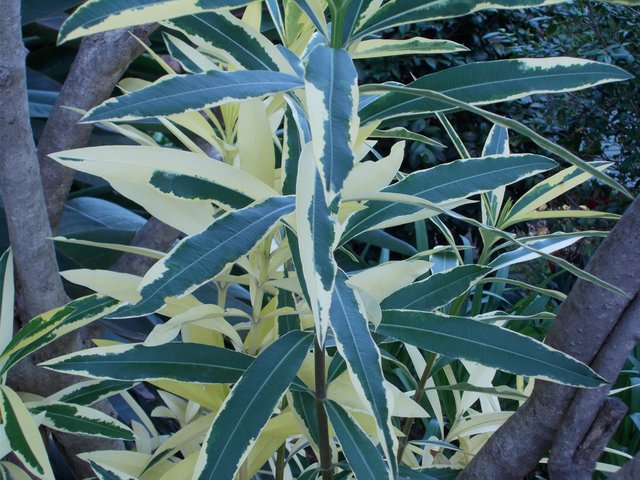
Resteem
Downvoting a post can decrease pending rewards and make it less visible. Common reasons:
Submit
Its amazing how u see a flower has more than one colour that blends and looks very attractive.
Its thrilling how they beautify, while some medicinal and some are healers to peoples hearts and some deadly. Hahaha. Wow.. I just can't love them enough..
And really,
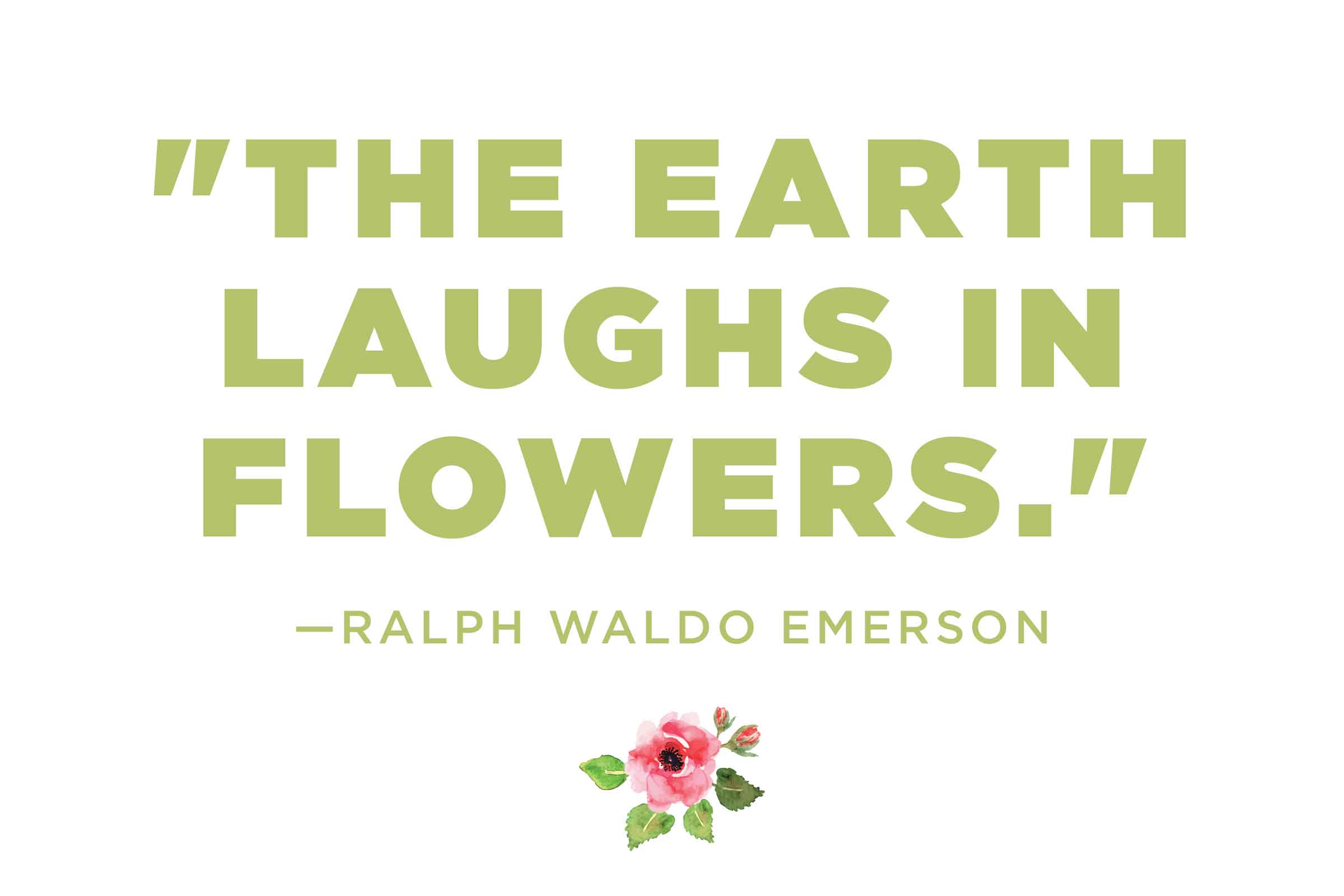
Downvoting a post can decrease pending rewards and make it less visible. Common reasons:
Submit
We do have that in our garden.
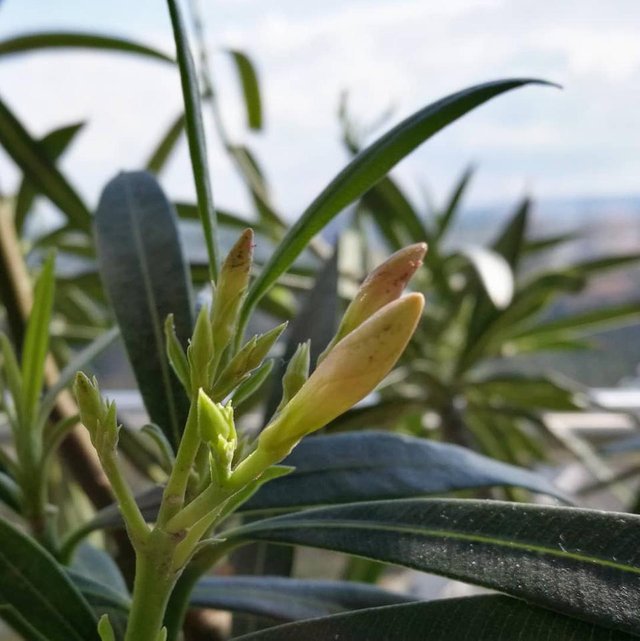
But the flowers havnt come out yet ,it looks beautiful when the pink flower shows up ,spring time is best ..
Downvoting a post can decrease pending rewards and make it less visible. Common reasons:
Submit
@ctrl-alt-nwo - Sir according to your article this is a very dangerous but beautiful plant... I like it's flower but Sir the beauty hidden the poison... Valuable description & photography Sir...
+W+
Downvoting a post can decrease pending rewards and make it less visible. Common reasons:
Submit
Beauty comes in deadly flowers I guess. Nice article.
Downvoting a post can decrease pending rewards and make it less visible. Common reasons:
Submit
Drugs are designed to cure illnesses, but at times they can also become200px-Oleandrin-skeletal.svg instruments of death. And historically, many drugs originated as botanicals. Even today, many drugs and their active ingredients come from plant sources.
Awhile back, I came across an interesting report that described a drug from plant origin that can both cure and kill. As I read the article describing what is being developed from the sap of the oleander plant, I remembered what my mother used to tell me. “Stay away from the oleander. It’s poison!
The oleander plant (Nerium oleander) is a common shrub found in warm Southern climates. It grows as tall as twelve feet and produces beautiful, fragrant, colorful blossoms.
Oleander is indeed a poisonous plant. The milky sap from the leaves and stems contain oleandrin, a powerful cardiac glycoside so toxic that ingesting one leaf has been reported to kill a small child. Although documentation is poor regarding the exact toxicity of the sap, it’s been estimated that ingesting 15-20 leaves would kill a normal adult (Yes, I also wonder who would enjoy a lunch of oleander leaves).
Symptoms of an overdose include gastrointestinal (nausea, vomiting, diarrhea), cardiac (interestingly, both lethal slowing and rapid increases in heart rates) and neurological (tremors, loss of muscle control, seizures).
Accidental poisoning from oleandrin ingestion can be deadly and articles are published so that physicians have established medical protocols to deal with such potentially lethal poisoning.
On the other hand, oleandrin—when properly prepared as a drug—has been used beneficially for years. In Russia and China, it is used to treat congestive heart failure and cardiac arrhythmias. An interesting tidbit is that it is also a popular method of suicide in both of those countries. Such actions are also becoming a growing concern in Sri Lanka.
Presently, oleandrin is being studied as a promising anti-cancer treatment. Patented drug extracts are being investigated at the Memorial Sloan Kettering Cancer Center for various innovative treatments of cancers. Other studies have investigated the cytotoxic properties of oleandrin for treating melanomas.
As I’ve read about these new drug developments, I thought about how drugs have been used throughout the ages to cure and kill. Ancient alchemy, as a precursor to modern pharmacology, produced wonderful life-saving medicines while at the same time spawning lethal poisons for primitive weapons such as darts and arrows.Modern pharmacology has furthered this balance of curative and lethal science in much the same way—so many ways to heal, and yet so many methods to kill. I find it especially interesting that many modern drugs have a narrow therapeutic window in that a small amount of drug is good, but a little more can be deadly
Downvoting a post can decrease pending rewards and make it less visible. Common reasons:
Submit
I used to work in a horticultural nursery as a teenager and these were a great seller for us.
Downvoting a post can decrease pending rewards and make it less visible. Common reasons:
Submit
a deadliest plant, proper care should be taken while cutting it, gloves should be used and should cut the lower short stems first then cut it halfway down...
Downvoting a post can decrease pending rewards and make it less visible. Common reasons:
Submit
Magoo-2 found a series of multi accounts of a same owner is following your articles to cheat your generous rewards.
Magoo-2 found these accounts are suspicious & can be multi accounts of a single owner. Conclusion is based on last 30 days transactions:
@mumin007
@naqshab02
@muhasib
@sheikhiqra
@hariszahoor
@zahidmalik
@chaddiman
magoo-2
Check our latest multi comment spam update report
Downvoting a post can decrease pending rewards and make it less visible. Common reasons:
Submit
Oleander does seems pretty beautiful and like you said quite dangerous as it seems !
Nice of you to buddy to introduce it to us !
Downvoting a post can decrease pending rewards and make it less visible. Common reasons:
Submit
Can I suggest this beautiful flower a new name?
Nerium 'dont touch too much' oleander
Downvoting a post can decrease pending rewards and make it less visible. Common reasons:
Submit
The Origins of Oleander
Known in ancient texts as “the desert rose,” historical references show that 15th century B.C. Mesopotamians trusted in the healing benefits of oleander extracts. From a remedy for hangovers to a herb studied for cancer, the Babylonians, Romans, Arabs and ancient Greeks alike used this herbal extract for a variety of health concerns.
Oleander, also known as laurier rose, dogbane and rosebay, is native to the Western Himalayas. It is an incredibly hardy, adaptable plant which grows thick and green in mountainous climates.
Quickly growing, this plant bears clusters of lovely pinkish-white and red flowers in the spring time. Traditionally, oleander leaf has been used to treat a number of health conditions. If you live in the southern United States, chances are you or your neighbors may have some growing in the yard.
Modern studies show that while no single chemical component of the extract can be stated as the sole source of its health benefits, the powerful activity of the plant comes from a highly complex amalgamation of components held within the combined form of the extract. These components work synergistically to boost and stimulate the human immune system, offering support for a wide variety of health concerns.
Downvoting a post can decrease pending rewards and make it less visible. Common reasons:
Submit
A few days earlier my brother said Gaargh!’ as he sprang back from the Oleander bush (Nerium oleander) in our yard. He was inspecting the little nest that a sunbird had built deep inside the foliage. When he turned a leaf over, he found himself nose-to-nose with what looked like the hugest, stripiest caterpillar in the world. These are beautiful pictures.
Downvoting a post can decrease pending rewards and make it less visible. Common reasons:
Submit
The exotic blooms of the oleander are a wonderful sight to see. However, despite being an everyday sight in the Mediterranean, this flower has the poisonous ability to cause diarrhoea, convulsion and vomiting.
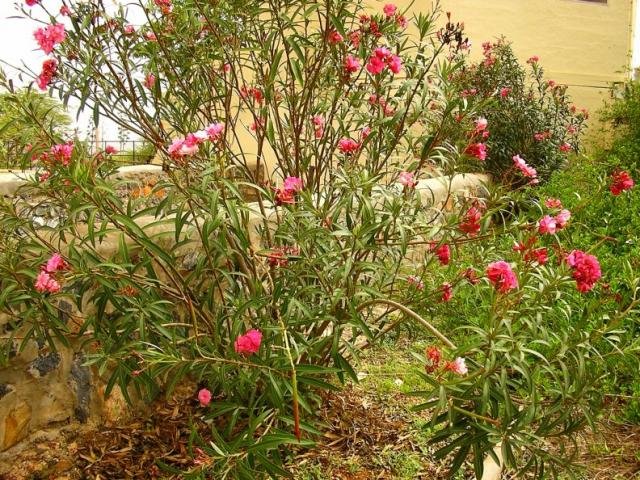
Downvoting a post can decrease pending rewards and make it less visible. Common reasons:
Submit
beauty with toxic.. great details and I have learn something today.
thanks @ctrl-alt-nwo
Cheers!
Downvoting a post can decrease pending rewards and make it less visible. Common reasons:
Submit
really beautiful flowers sir...👌☺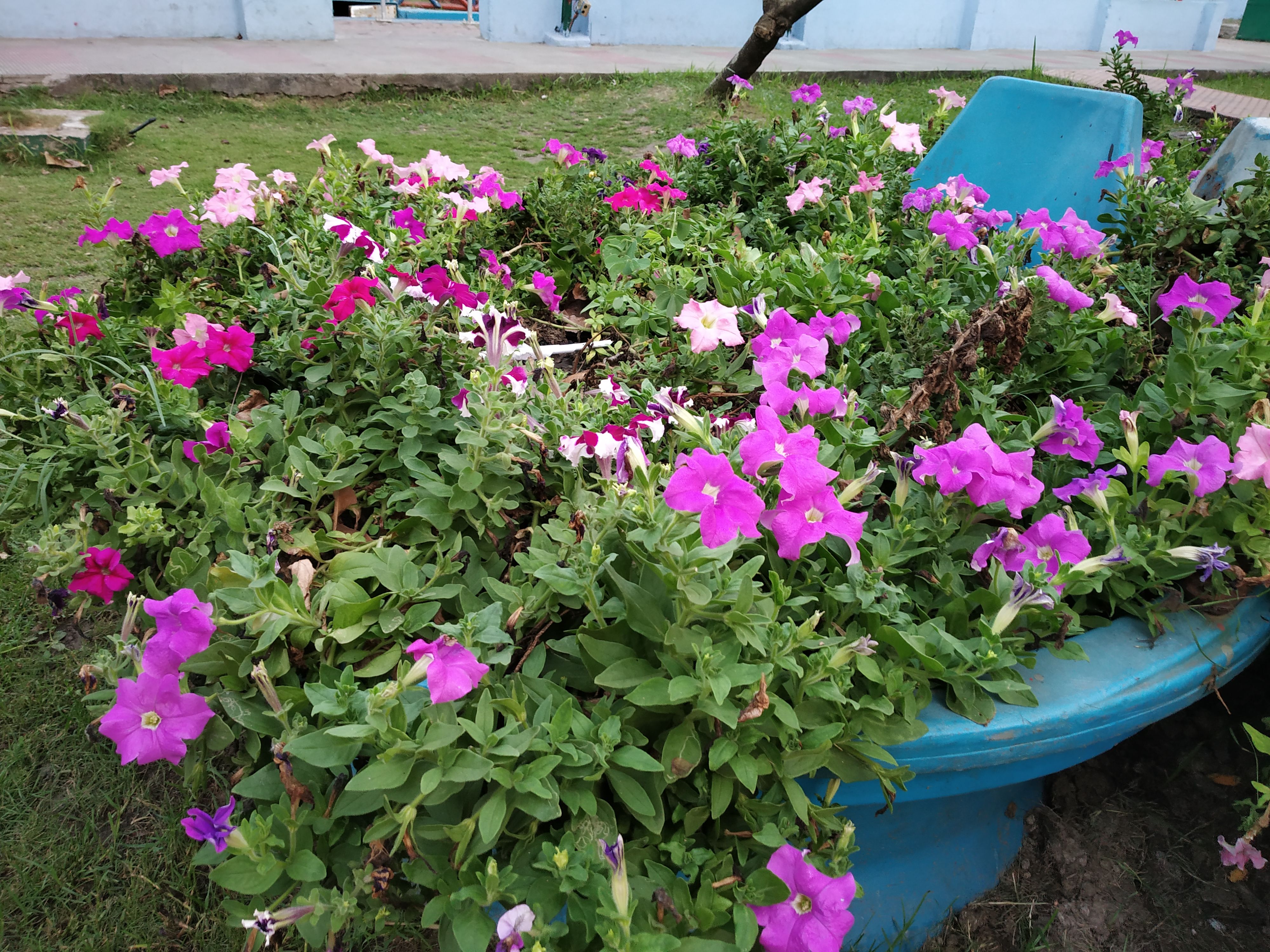
i clicked yesterday
Downvoting a post can decrease pending rewards and make it less visible. Common reasons:
Submit
Wow fantastic garden . wonderful work. i like this Oleander trees .

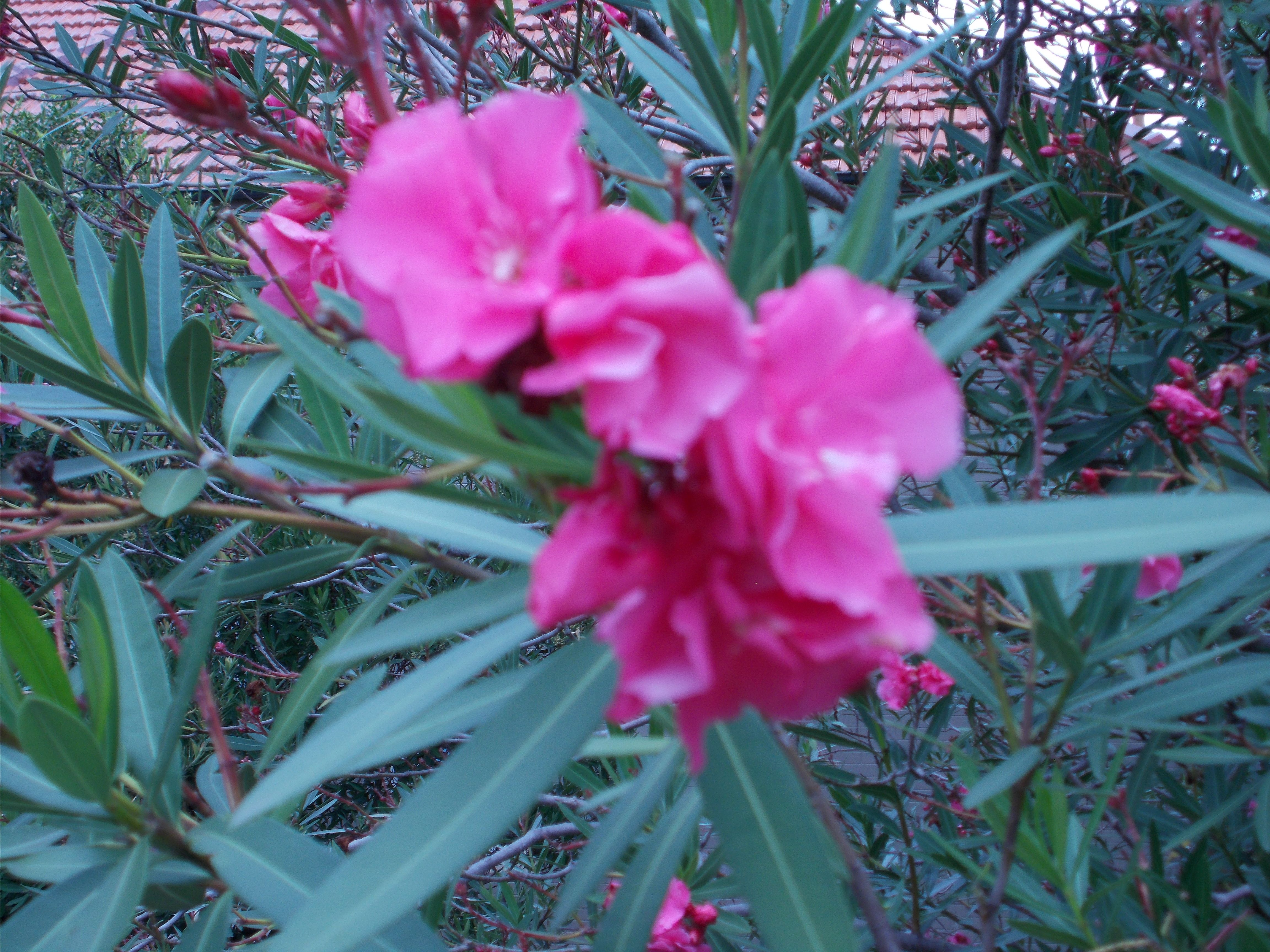
resteem
Downvoting a post can decrease pending rewards and make it less visible. Common reasons:
Submit
I am medicenal professional i investigate that oleander is a shrub thats used for medicenal perposes.
I also like it due to its beauty of flowers &leaves.
Downvoting a post can decrease pending rewards and make it less visible. Common reasons:
Submit
Bi colored leaf.... Now how often do u see that...😎😎😎
Downvoting a post can decrease pending rewards and make it less visible. Common reasons:
Submit
Beauty to see not to touch .... This is how plants have been saving themselves for years.. A similar e.g of saviour is of rose plant....
Downvoting a post can decrease pending rewards and make it less visible. Common reasons:
Submit
This is great article and wonderful photography.

@ctrl-alt-nwo
Upvote Resteem
Downvoting a post can decrease pending rewards and make it less visible. Common reasons:
Submit
It's environment friendly plant . Mixture of colors .
Downvoting a post can decrease pending rewards and make it less visible. Common reasons:
Submit
nice post
Downvoting a post can decrease pending rewards and make it less visible. Common reasons:
Submit
magoo-2 found a series of multi accounts of a same owner is following your articles to cheat your generous rewards.
magoo-2 found these accounts are suspicious & can be multi accounts of a single owner. Conclusion is based on last 30 days transactions:
@moniristi, @shishiristi
magoo-2
Check our latest multi comment spam update report
Downvoting a post can decrease pending rewards and make it less visible. Common reasons:
Submit
This is really beautiful, After women, flowers are the most lovely thing God has given the world.
Downvoting a post can decrease pending rewards and make it less visible. Common reasons:
Submit
Magoo-2 found a series of multi accounts of a same owner is following your articles to cheat your generous rewards.
Magoo-2 found these accounts are suspicious & can be multi accounts of a single owner. Conclusion is based on last 30 days transactions:
@mumin007
@naqshab02
@muhasib
@sheikhiqra
@hariszahoor
@zahidmalik
@chaddiman
magoo-2
Check our latest multi comment spam update report
Downvoting a post can decrease pending rewards and make it less visible. Common reasons:
Submit
Wow thats beautiful and pretty, one of the major pretty things that made this world look beautiful. ;-)
Downvoting a post can decrease pending rewards and make it less visible. Common reasons:
Submit
nice photos and very cool garden
Downvoting a post can decrease pending rewards and make it less visible. Common reasons:
Submit
So beautiful flowers . Colourful photo
Downvoting a post can decrease pending rewards and make it less visible. Common reasons:
Submit
Magoo-2 found a series of multi accounts of a same owner is following your articles to cheat your generous rewards.
Magoo-2 found these accounts are suspicious & can be multi accounts of a single owner. Conclusion is based on last 30 days transactions:
@ritue
@pariza
@suchi
@maicle
@quinnpeterson
@ziaurrahma
@steemitsabbir1
@utpolbiswas
@davitone
@steemitsabbir1
magoo-2
Check our latest multi comment spam update report
Downvoting a post can decrease pending rewards and make it less visible. Common reasons:
Submit
Beautiful photography.Awesome great work sir.have a great day.
Downvoting a post can decrease pending rewards and make it less visible. Common reasons:
Submit
They are looking very beautiful and especially the flowers !
Downvoting a post can decrease pending rewards and make it less visible. Common reasons:
Submit
That's so beautiful to see very different and amazing they look thanks for sharing :D
Downvoting a post can decrease pending rewards and make it less visible. Common reasons:
Submit
you are the best in exploring these trees,you are amazing sir.great job sir once again.
Downvoting a post can decrease pending rewards and make it less visible. Common reasons:
Submit
Oh.... Theyre beautiful to behold...
Downvoting a post can decrease pending rewards and make it less visible. Common reasons:
Submit
wow these are amazing,thanks a lot you have made my day.
Downvoting a post can decrease pending rewards and make it less visible. Common reasons:
Submit
Soo beautiful white rose, my most favorite color in flowers!
But looks soo pretty also in this shape.
Downvoting a post can decrease pending rewards and make it less visible. Common reasons:
Submit
How can some of the most beautiful plants be so toxic? Take oleander—that wonderfully large shrub that, despite high winds and salt spray along our coastlines, somehow manages to produce clusters of gorgeous blooms in summer in white, yellow, peach, salmon, pink or red. And yet oleander is considered one of the most poisonous plants in the world. All parts of this gracefully mounded shrub contain poison; a single leaf ingested by a child is known to be deadly.
But, as with thorny roses, prickly cacti, and toxic holiday plants, knowledge is key in preventing hazardous encounters with these landscape beauties. Native to the Far East and the Mediterranean, oleanders, Nerium oleander, grow easily—and rapidly—in the United States, especially southern coastal climes, where they’re often planted along highways as a noise and pollution barrier. These evergreens thrive with little care and are very tolerant of heat and drought. Most will survive temperatures as low as 15 to 20 degrees, though their foliage may get damaged. Yet even then, the shrubs recover quickly in spring so long as their roots are not harmed.
Oleanders grow best in full sun, and most reach 8 to 15 feet tall and as wide, so make sure you give these big guys plenty of space in the landscape. They flower from early summer until mid-autumn with large clusters of 2-inch single or double blossoms. Their long, narrow leaves are smooth but leathery.
A few cultivars to consider include:
'Algiers' features single, dark red flowers.
‘Calypso’ is cold hardy with cherry red single flowers.
‘Hardy Red' is extremely cold hardy with deep red single blooms.
‘Petite Salmon’ is a dwarf plant but less cold hardy than most oleanders.
‘Sister Agnes’ is hardy, grows to 12 feet and has large single white flowers.
thanks for this post. for sharing
100% like and resteem
Downvoting a post can decrease pending rewards and make it less visible. Common reasons:
Submit